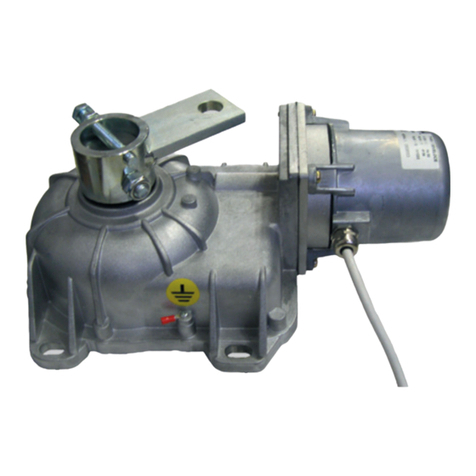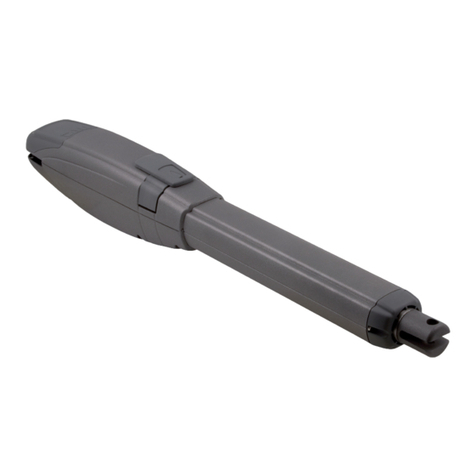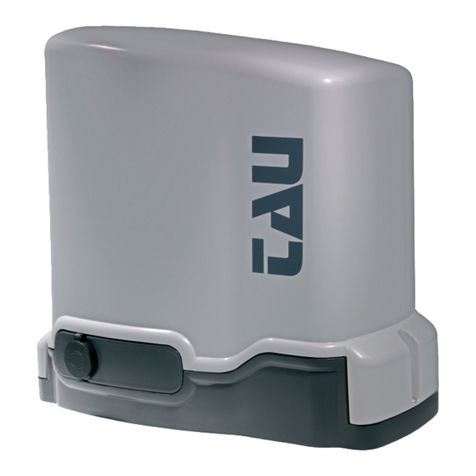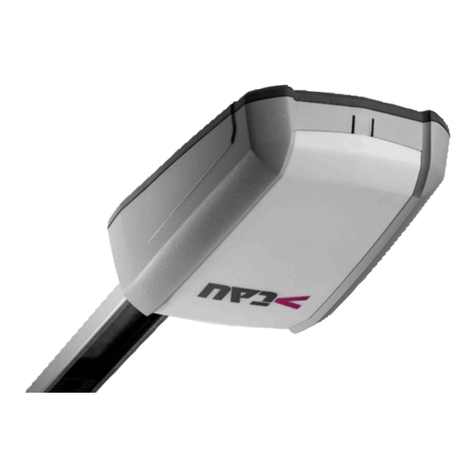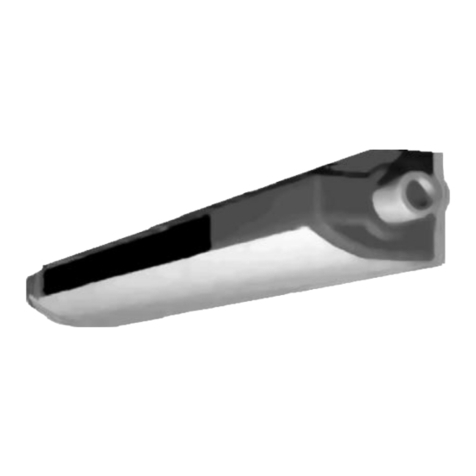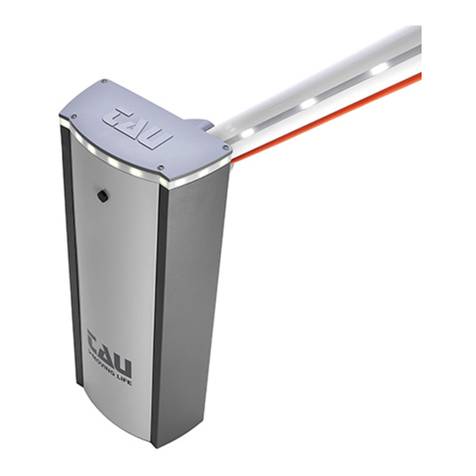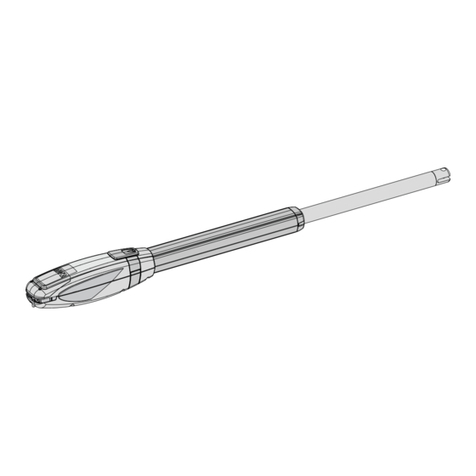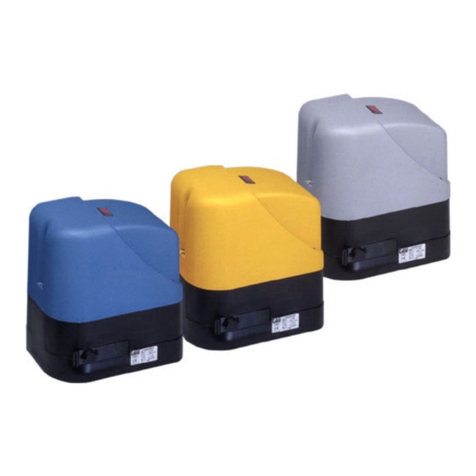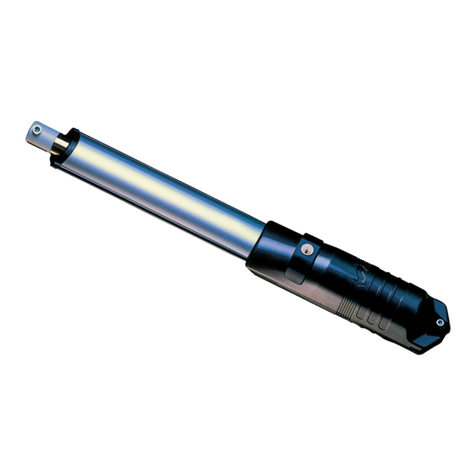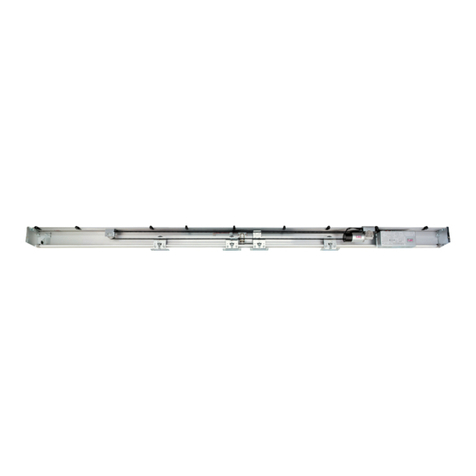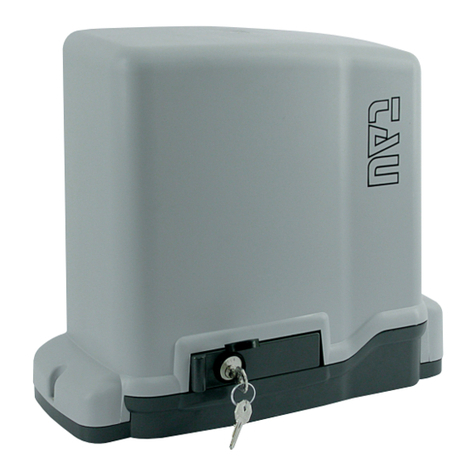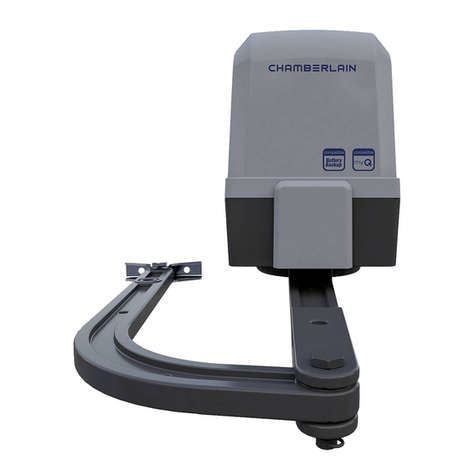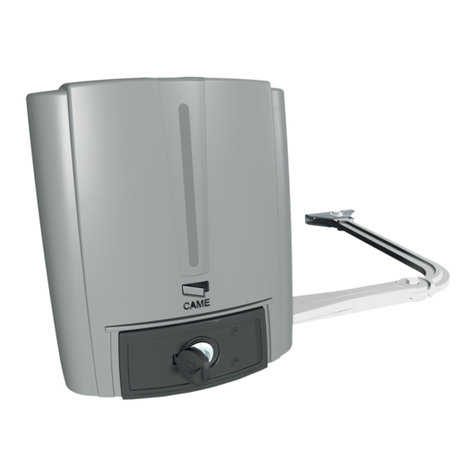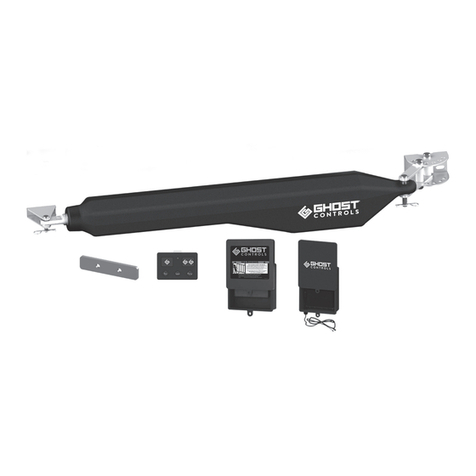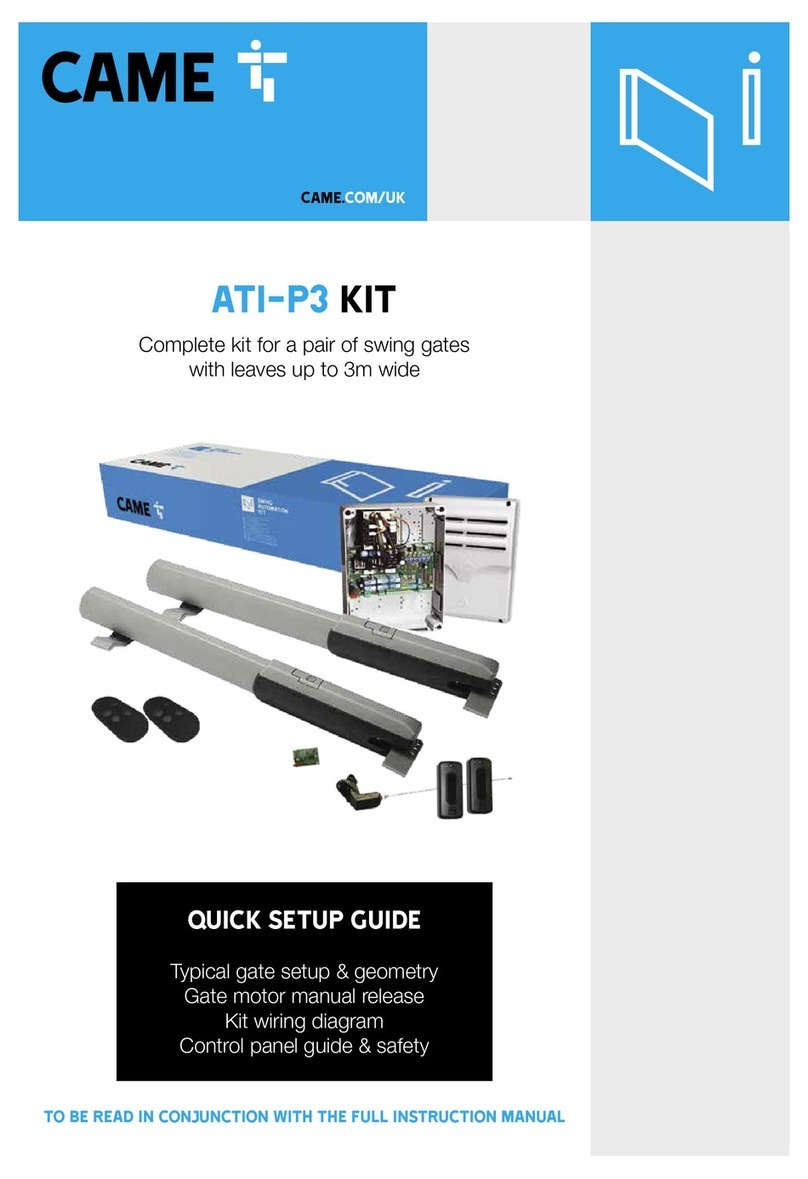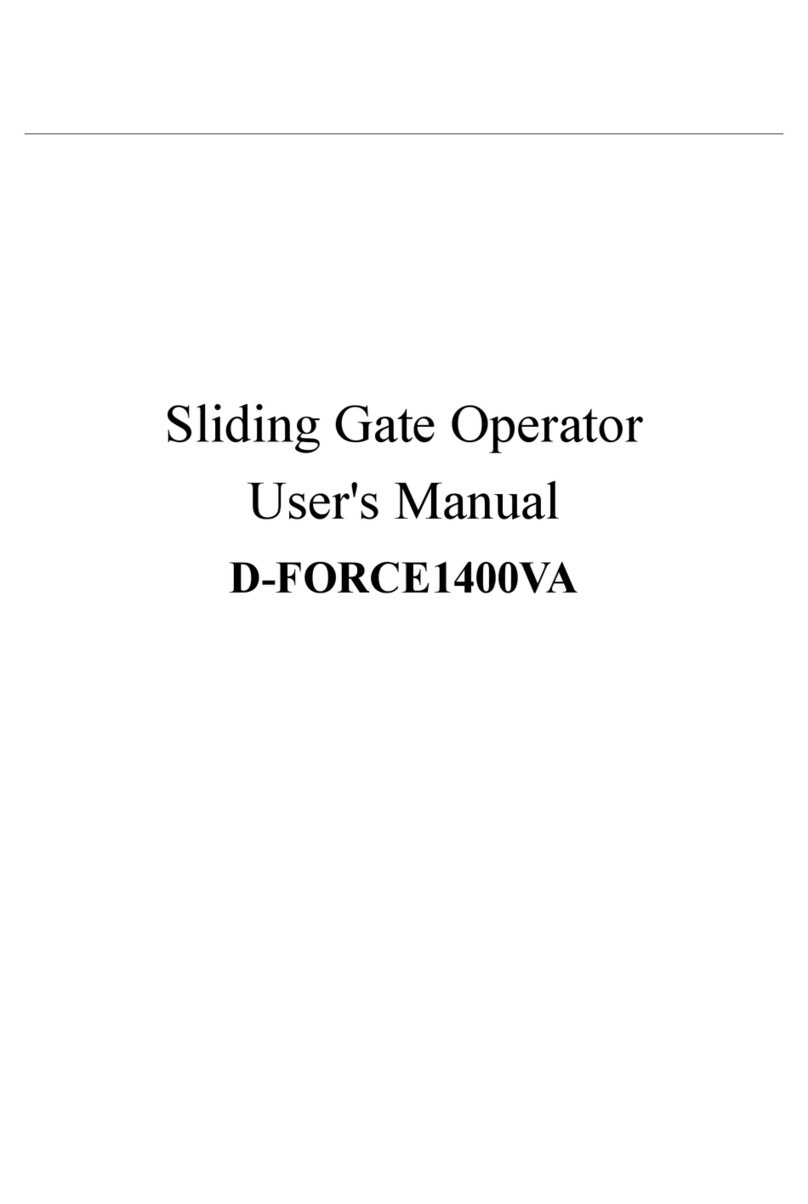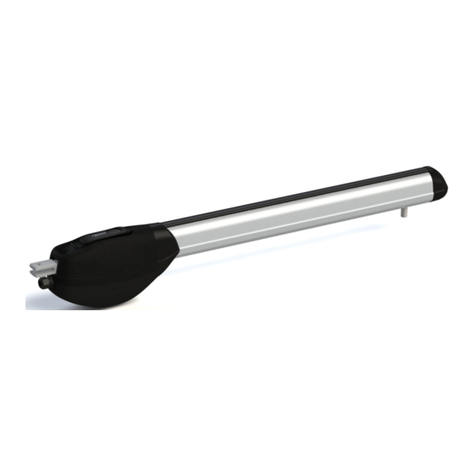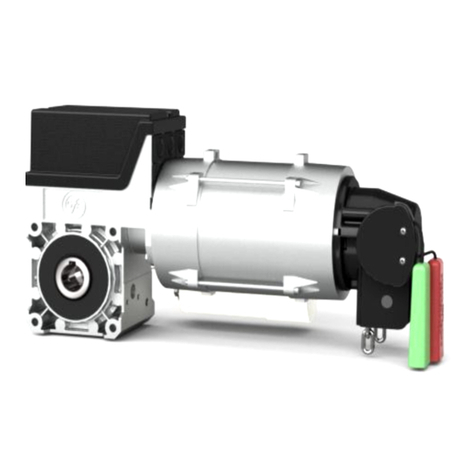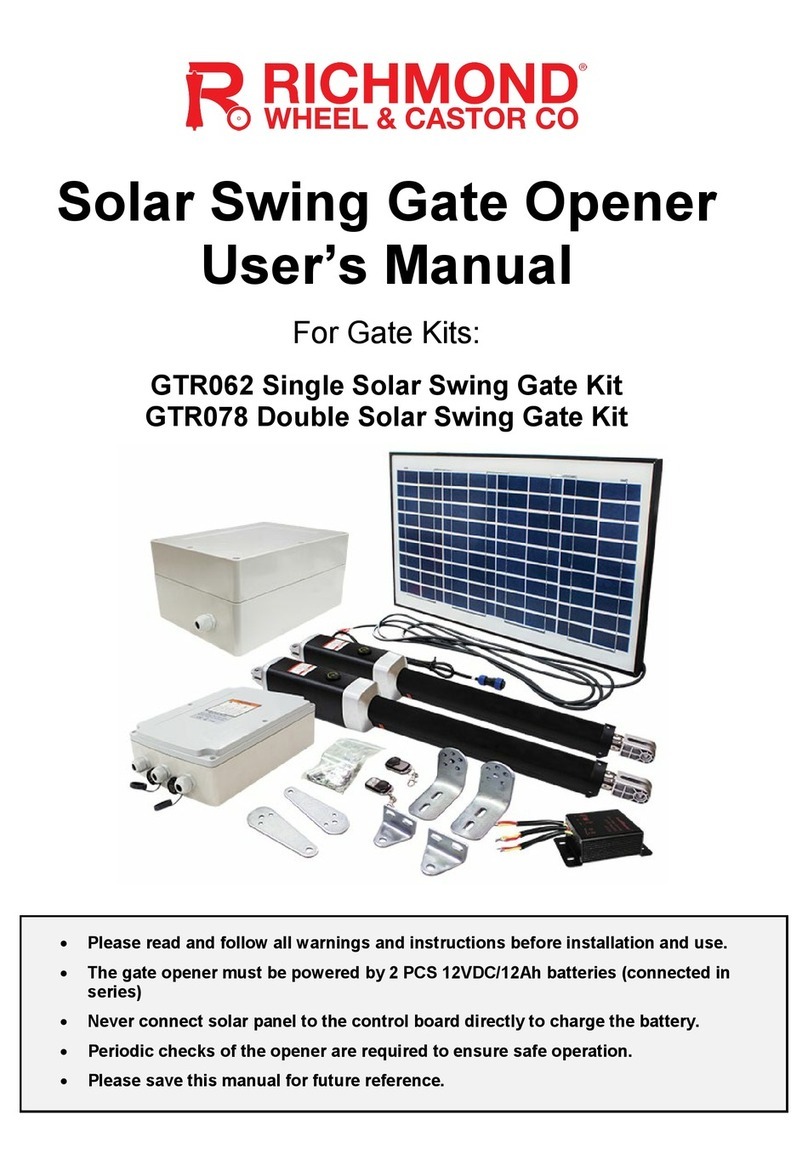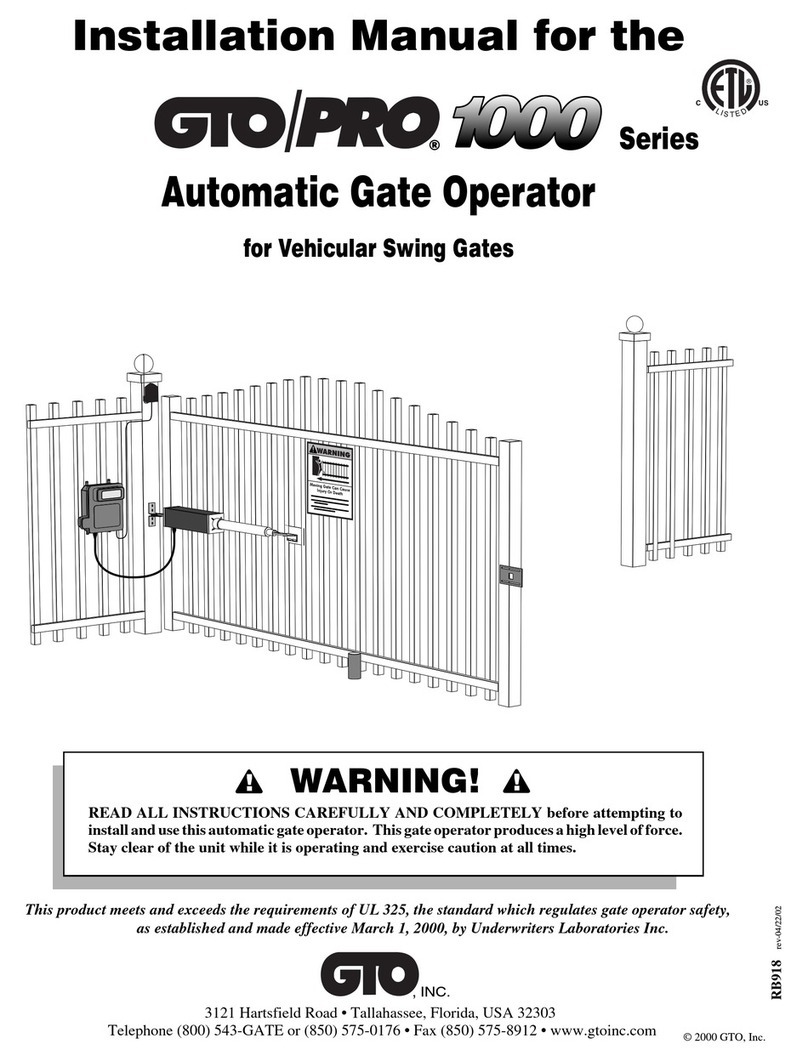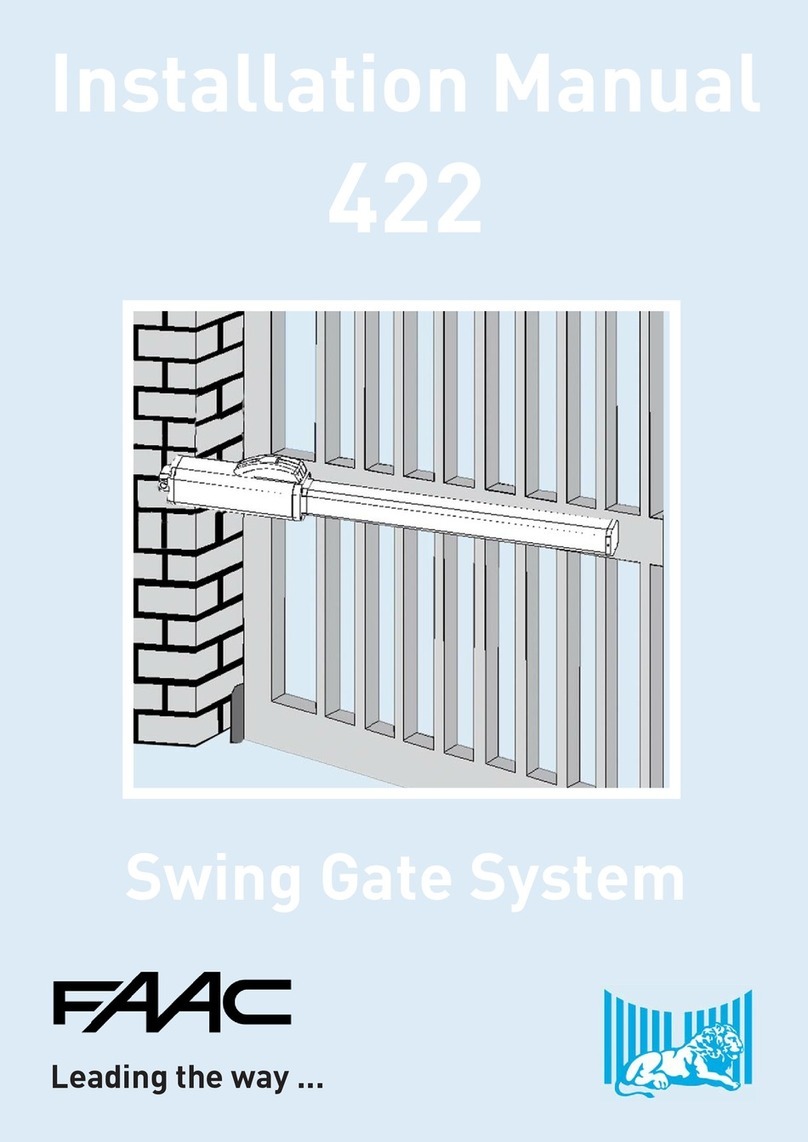tau ARM2000 User manual

1
ARM2000 Series
MANUALE D’USO E MANUTENZIONE
USE AND MAINTENANCE MANUAL
BEDIENUNGS - UND WARTUNGSANLEITUNG
MANUEL D’EMPLOI ET D’ENTRETIEN
MANUAL DE USO Y MANTENIMIENTO
ARM2000
Automatismo per Cancelli a Battente - Uso Residenziale/Condominiale
Swing Gate Operator - Residential/Communities
Drehtorantrieb für Privat und Gewerbe
Automatisme pour Portails à Battant – Usage Résidentiel/Intensif
Accionador para Puertas Batientes – Uso Residencial/Comunidades
Via Enrico Fermi, 43 - 36066 Sandrigo (VI) Italia
Tel +39 0444 750190 - Fax +39 0444 750376 - info@tauitalia.com - www.tauitalia.com
IT - Istruzioni originali
D_MNL0ARM2000 16-09-2016 - Rev.26

2
ARM2000 Series
Italiano
Español
English
Français
Deutsch
I dati riportati nel presente manuale sono puramente indicativi. La TAU si riserva il diritto di modicarli in qualsiasi momento.
La Casa costruttrice si riserva il diritto di apportare modiche o miglioramenti al prodotto senza alcun preavviso. Eventuali imprecisioni
o errori riscontrabili nel presente fascicolo, saranno corretti nella prossima edizione.
All’apertura dell’imballo vericare che il prodotto sia integro. Riciclare i materiali secondo la normativa vigente.
L’installazione del prodotto dovrà essere effettuata da personale qualicato. La Ditta costruttrice Tau declina ogni responsabilità
per danni derivanti a cose e/o persone dovuti ad un’eventuale errata installazione dell’impianto o la non messa a Norma dello
stesso secondo le vigenti Leggi (vedi Direttiva Macchine).
Los datos describidos en este manual son puramente indicativos. La TAU se reserva el derecho de modicarlos en cualquier
momento.
El Fabricante se reserva el derecho de modicar o actualizar el producto sin aviso previo. Posibles imprecisiones o errores en este
manual serán corregidos en la próxima edición.
Cuando abra el embalaje, controle que el producto esté íntegro. Recicle los materiales según la normativa vigente.
La instalación del producto tiene que ser efectuada por personal cualicado. El Fabricante Tau no se asume ninguna
responsabilidad por lesiones a personas o averías a cosas causadas por una instalación incorrecta del equipo o la por la
inobservancia de la normativa vigente (véase Directiva de Máquinas).
The data described in this handbook are purely a guide. TAU reserves the right to change them in any moment.
The manufacturer reserves the right to modify or improve products without prior notice. Any inaccuracies or errors found in this handbook
will be corrected in the next edition.
When opening the packing please check that the product is intact. Please recycle materials in compliance with current regulations.
This product may only be installed by a qualied tter. The manufacturer declines all liability for damage to property and/or
personal injury deriving from the incorrect installation of the system or its non-compliance with current law (see Machinery
Directive).
Les données décrites dans ce manual sont purement indicatives. La TAU se réserve le droit de les modier à n’importe quel moment.
Le Constructeur se réserve le droit d’apporter des modications ou des améliorations au produit sans aucun préavis. Les éventuelles
imprécisions ou erreurs présentes dans ce fascicule seront corrigées dans la prochaine édition.
À l’ouverture de l’emballage, vérier que le produit est intact. Recycler les matériaux suivant les normes en vigueur.
L’installation du produit devra être effectuée par du personnel qualié. Tau décline toute responsabilité pour les dommages
aux choses et/ou personnes dus à une éventuelle installation erronée de l’automatisme ou à la non-mise aux normes suivant
les lois en vigueur (voir Directive Machines).
Die beschriebenen Daten in der vorliegenden Betriebsanleitung sind rein indikativ. TAU behält sich vor, diese in jedem Moment zu
modizieren.
Der Hersteller behält sich das Recht vor, ohne vorherige Benachrichtung Änderungen oder Verbesserungen am Produkt anzubringen.
Ungenauigkeiten oder Fehler, die in der vorliegenden Ausgabe festgestellt werden, werden in der nächsten Ausgabe berichtigt.
Beim Öffnen der Verpackung prüfen, dass das Produkt keine Schäden aufweist. Die Materialien nach den gültigen Vorschriften
recyclen.
Die Installation des Produktes muss von Fachpersonal ausgeführt werden. Die Herstellerrma TAU übernimmt keinerlei
Haftung für Personen- und/oder Sachschäden aufgrund einer falschen Installation der Anlage oder der Nichtkonformität
derselben mit den gültigen Gesetzen (siehe Maschinenrichtlinie).

3
ARM2000 Series
AVVERTENZE PER L’INSTALLATORE
OBBLIGHI GENERALI PER LA SICUREZZA
A) Leggere attentamente le istruzioni prima di procedere all’installazione, in quanto forniscono importanti indicazioni concernenti la
sicurezza, l’installazione, l’uso e la manutenzione. Una errata installazione o un errato uso del prodotto può portare a gravi danni alle
persone.
B) I materiali dell’imballaggio (plastica, polistirolo, ecc.) non devono essere lasciati alla portata dei bambini in quanto potenziali fonti di pericolo.
C) Conservare le istruzioni per riferimenti futuri.
D) Questo prodotto è stato progettato e costruito esclusivamente per l’utilizzo indicato in questa documentazione. Qualsiasi altro utilizzo non
espressamente indicato potrebbe pregiudicare l’integrità del prodotto e/o rappresentare fonte di pericolo.
E) TAU declina qualsiasi responsabilità derivata dall’uso improprio o diverso da quello per cui l’automatismo è destinato.
F) Non installare il prodotto in ambiente e atmosfera esplosivi.
G) Gli elementi costruttivi meccanici devono essere in accordo con quanto stabilito dalle Norme EN 12604 e EN 12605. Per i Paesi extra-CEE, oltre
ai riferimenti normativi nazionali, per ottenere un livello di sicurezza adeguato, devono essere seguite le Norme sopra riportate.
H) TAU non è responsabile dell’inosservanza della Buona Tecnica nella costruzione delle chiusure da motorizzare, nonché delle deformazioni che
dovessero intervenire nell’utilizzo.
I) L’installazione deve essere effettuata nell’osservanza delle Norme EN 12453 e EN 12445. Il livello di sicurezza dell’automazione deve essere
C+D.
J) Prima di effettuare qualsiasi intervento sull’impianto, togliere l’alimentazione elettrica e scollegare le batterie.
K) Prevedere sulla rete di alimentazione dell’automazione un interruttore onnipolare con distanza d’apertura dei contatti uguale o superiore a 3 mm.
È consigliabile l’uso di un magnetotermico da 6A con interruzione onnipolare.
L) Vericare che a monte dell’impianto vi sia un interruttore differenziale con soglia da 0,03 A.
M) Vericare che l’impianto di terra sia realizzato a regola d’arte e collegarvi le parti metalliche della chiusura.
N) L’automazione dispone di una sicurezza intrinseca antischiacciamento costituita da un controllo di coppia. E’ comunque necessario vericarne
la soglia di intervento secondo quanto previsto dalle Norme indicate al punto I.
O) I dispositivi di sicurezza (norma EN 12978) permettono di proteggere eventuali aree di pericolo da Rischi meccanici di movimento, come ad Es.
schiacciamento, convogliamento, cesoiamento.
P) Per ogni impianto è consigliato l’utilizzo di almeno una segnalazione luminosa nonché di un cartello di segnalazione ssato adeguatamente sulla
struttura dell’insso, oltre ai dispositivi citati al punto O.
Q) Il costruttore dell’automazione declina ogni responsabilità qualora vengano installati componenti incompatibili ai ni della sicurezza e del buon
funzionamento. Per l’eventuale riparazione o sostituzione dei prodotti dovranno essere utilizzati esclusivamente ricambi originali.
R) Per la manutenzione utilizzare esclusivamente parti originali TAU.
S) Non eseguire alcuna modica sui componenti facenti parte del sistema d’automazione.
T) L’installatore deve fornire tutte le informazioni relative al funzionamento manuale del sistema in caso di emergenza e consegnare all’Utente
utilizzatore dell’impianto la “Guida Utente” allegata al prodotto.
U) Non permettere ai bambini o persone di sostare nelle vicinanze del prodotto durante il funzionamento.
W) Tenere fuori dalla portata dei bambini radiocomandi o qualsiasi altro datore di impulso, per evitare che l’automazione possa essere azionata
involontariamente.
X) Il transito tra le ante deve avvenire solo a cancello completamente aperto.
Y) L’Utente utilizzatore deve astenersi da qualsiasi tentativo di riparazione o d’intervento diretto e rivolgersi solo a personale qualicato.
Z) Tutto quello che non è previsto espressamente in queste istruzioni non è permesso.
Consigliamo di riporre tutta la documentazione relativa all’impianto all’interno o nelle immediate vicinanze della centralina.
Italiano
IMPORTANT NOTICE FOR THE INSTALLER
GENERAL SAFETY REGULATIONS
A) Please read these instructions carefully before installing the product as they contain important information concerning safety,
installation, use and maintenance. Incorrect installation or incorrect use of the product could cause serious harm to people.
B) Do not leave packing materials (plastic, polystyrene, etc.) within reach of children as such materials are potential sources of danger.
C) Store these instructions for future reference.
D) This product was designed and built strictly for the use indicated in this documentation. Any other use, not expressly indicated here, could
compromise the good condition/operation of the product and/or be a source of danger.
E) TAU declines all liability caused by improper use or use other than that for which the automated system was intended.
F) Do not install the product in explosive environments.
G) The mechanical parts must conform to the provisions of Standards EN 12604 and EN 12605. For non-EU countries, to obtain an adequate level
of safety, the Standards mentioned above must be observed, in addition to national legal regulations.
H) TAU is not responsible for failure to observe Good Technique in the construction of the closing elements to be motorised, or for any deformation
that may occur during use.
I) The installation must conform to Standards EN 12453 and EN 12445. The safety level of the automated system must be C+D.
J) Before attempting any job on the system, cut out electrical power and disconnect the batteries.
K) The mains power supply of the automated system must be tted with an all-pole switch with contact opening distance of 3mm or greater. Use of
a 6A thermal breaker with all-pole circuit break is recommended.
L) Make sure that a differential switch with threshold of 0.03 A is tted upstream of the system.
M) Make sure that the earthing system is perfectly constructed, and connect metal parts of the means of the closure to it.
N) The automated system is supplied with an intrinsic anti-crushing safety device consisting of a torque control. Nevertheless, its tripping threshold
must be checked as specied in the Standards indicated at point “I”.
O) The safety devices (EN 12978 standard) protect any danger areas against mechanical movement Risks, such as crushing, dragging, and
shearing.
P) Use of at least one indicator-light is recommended for every system, as well as a warning sign adequately secured to the frame structure, in
addition to the devices mentioned at point “O”.
Q) The manufacturer declines all liability if incompatible safety and components are installed. Only use original spare parts to repair or replace the
product.
R) For maintenance, strictly use original parts by TAU.
S) Do not in any way modify the components of the automated system.
T) The installer shall supply all information concerning manual operation of the system in case of an emergency, and shall hand over to the user
the “User Guide” supplied with the product.
U) Do not allow children or adults to stay near the product while it is operating.
W) Keep remote controls or other pulse generators away from children, to prevent the automated system from being activated involuntarily.
X) Transit through the leaves is allowed only when the gate is fully open.
Y) The user must not attempt any kind of repair or direct action whatever and contact qualied personnel only.
Z) Anything not expressly specied in these instructions is not permitted.
Keep all the documents concerning the system inside or near the central control unit.
English

4
ARM2000 Series
CONSIGNES POUR L’INSTALLATEUR
RÈGLES DE SÉCURITÉ
A) Lire attentivement les instructions avant de procéder à l’installation, dans la mesure où elles fournissent des indications importantes concernant la
sécurité, l’installation, l’emploi et la maintenance. Une installation erronée ou un usage erroné du produit peut entraîner de graves conséquences
pour les personnes.
B) Les matériaux d’emballage (matière plastique, polystyrène, etc.) ne doivent pas être laissés à la portée des enfants car ils constituent des sources potentielles
de danger.
C) Conserver les instructions pour les références futures.
D) Ce produit a été conçu et construit exclusivement pour l’usage indiqué dans cette documentation. Toute autre utilisation non expressément indiquée pourrait
compromettre l’intégrité du produit et/ou représenter une source de danger.
E) TAU décline toute responsabilité qui dériverait d’usage impropre ou différent de celui auquel l’automatisme est destiné.
F) Ne pas installer le produit dans un environnement et une atmosphère explosifs.
G) Les composants mécaniques doivent répondre aux prescriptions des Normes EN 12604 et EN 12605. Pour les Pays extra-CEE, l’obtention d’un niveau de
sécurité approprié exige non seulement le respect des normes nationales, mais également le respect des Normes susmentionnées.
H) TAU n’est pas responsable du non-respect de la Bonne Technique dans la construction des fermetures à motoriser, ni des déformations qui pourraient intervenir
lors de l’utilisation.
I) L’installation doit être effectuée conformément aux Normes EN 12453 et EN 12445. Le niveau de sécurité de l’automatisme doit être C+D.
J) Couper l’alimentation électrique et déconnecter la batterie avant toute intervention sur l’installation.
K) Prévoir, sur le secteur d’alimentation de l’automatisme, un interrupteur omnipolaire avec une distance d’ouverture des contacts égale ou supérieure à 3 mm. On
recommande d’utiliser un magnétothermique de 6A avec interruption omnipolaire.
L) Vérier qu’il y ait, en amont de l’installation, un interrupteur différentiel avec un seuil de 0,03 A.
M) Vérier que la mise à terre est réalisée selon les règles de l’art et y connecter les pièces métalliques de la fermeture.
N) L’automatisme dispose d’une sécurité intrinsèque anti-écrasement, formée d’un contrôle du couple. Il est toutefois nécessaire d’en vérier le seuil d’intervention
suivant les prescriptions des Normes indiquées au point “I”.
O) Les dispositifs de sécurité (norme EN 12978) permettent de protéger des zones éventuellement dangereuses contre les Risques mécaniques du mouvement,
comme l’écrasement, l’acheminement, le cisaillement.
P) On recommande que toute installation soit doté au moins d’une signalisation lumineuse, d’un panneau de signalisation xé, de manière appropriée, sur la
structure de la fermeture, ainsi que des dispositifs cités au point “O”.
Q) Le constructeur de l’automatisme décline toute responsabilité en cas d’installation de composants incompatibles en matière de sécurité et de bon fonctionnement.
Pour toute réparation ou pour tout remplacement des produits, il faudra utiliser exclusivement des pièces de rechange originales.
R) Utiliser exclusivement, pour l’entretien, des pièces TAU originales.
S) Ne jamais modier les composants faisant partie du système d’automatisme.
T) L’installateur doit fournir toutes les informations relatives au fonctionnement manuel du système en cas d’urgence et remettre à l’Usager qui utilise l’installation
le “Guide Usager” fournie avec le produit.
U) Interdire aux enfants ou aux tiers de stationner près du produit durant le fonctionnement.
W) Eloigner de la portée des enfants les radiocommandes ou tout autre générateur d’impulsions, pour éviter tout actionnement involontaire de l’automatisme.
X) Le transit entre les vantaux ne doit avoir lieu que lorsque le portail est complètement ouvert.
Y) L’Usager qui utilise l’installation doit éviter toute tentative de réparation ou d’intervention directe et s’adresser uniquement à un personnel qualié.
Z) Tout ce qui n’est pas prévu expressément dans ces instructions est interdit.
Nous conseillons de conserver toute la documentation relative à l’installation à l’intérieur de l’armoire de commande ou à proximité immédiate.
HINWEISE FÜR DEN INSTALLATIONSTECHNIKER
ALLGEMEINE SICHERHEITSVORSCHRIFTEN
A) Die Anweisungen vor der Installation genau lesen, da sie wichtige Hinweise mit Bezug auf Sicherheit, Installation, Bedienung und Wartung liefern.
Eine falsche Installation oder ein fehlerhafter Betrieb des Produktes können zu schwerwiegenden Personenschäden führen.
B) Das Verpackungsmaterial (Kunststoff, Styropor, usw.) sollte nicht in Reichweite von Kindern aufbewahrt werden, da es eine potentielle Gefahrenquelle
darstellt.
C) Die Anleitung sollte aufbewahrt werden, um auch in Zukunft Bezug auf sie nehmen zu können.
D) Dieses Produkt wurde ausschließlich für den in diesen Unterlagen angegebenen Gebrauch entwickelt und hergestellt. Jeder andere Gebrauch, der nicht
ausdrücklich angegeben ist, könnte die Unversehrtheit des Produktes beeinträchtigen und/oder eine Gefahrenquelle darstellen.
E) Die Firma TAU lehnt jede Haftung für Schäden, die durch unsachgemäßen oder nicht bestimmungsgemäßen Gebrauch der Automatik verursacht werden, ab.
F) Das Produkt nicht in EX-Umgebung bzw. EX-Atmosphäre installieren.
G) Die mechanischen Bauelemente müssen den Anforderungen der Normen EN 12604 und EN 12605 entsprechen. Für Länder, die nicht der Europäischen Union
angehören, sind für die Gewährleistung eines entsprechenden Sicherheitsniveaus neben den nationalen gesetzlichen Bezugsvorschriften die oben aufgeführten
Normen zu beachten.
H) Die Firma TAU übernimmt keine Haftung im Falle von nicht fachgerechten Ausführungen bei der Herstellung der anzutreibenden Schließvorrichtungen sowie bei
Deformationen, die eventuell beim Betrieb entstehen.
I) Die Installation muß unter Beachtung der Normen EN 12453 und EN 12445 erfolgen. Die Sicherheitsstufe der Automatik sollte C+D sein.
J) Vor der Ausführung jeglicher Eingriffe auf der Anlage sind die elektrische Versorgung und die Batterie abzunehmen.
K) Auf dem Versorgungsnetz der Automatik ist ein omnipolarer Schalter mit Öffnungsabstand der Kontakte von über oder gleich 3 mm einzubauen. Darüber hinaus
wird der Einsatz eines Magnetschutzschalters mit 6A mit omnipolarer Abschaltung empfohlen.
L) Es sollte überprüft werden, ob vor der Anlage ein Differentialschalter mit einer Auslöseschwelle von 0,03 A zwischengeschaltet ist.
M)
Es sollte überprüft werden, ob die Erdungsanlage fachgerecht ausgeführt wurde. Die Metallteile der Schließung sollten an diese Anlage angeschlossen werden.
N) Die Automation verfügt über eine eingebaute Sicherheitsvorrichtung für den Quetschschutz, die aus einer Drehmomentkontrolle besteht. Es ist in jedem Falle
erforderlich, deren Eingriffsschwelle gemäß der Vorgaben der unter Punkt “I” angegebenen Vorschriften zu überprüfen.
O) Die Sicherheitsvorrichtungen (Norm EN 12978) ermöglichen den Schutz eventueller Gefahrenbereiche vor mechanischen Bewegungsrisiken, wie zum Beispiel
Quetschungen, Mitschleifen oder Schnittverletzungen.
P) Für jede Anlage wird der Einsatz von mindestens einem Leuchtsignal empfohlen sowie eines Hinweisschildes, das über eine entsprechende Befestigung mit
dem Aufbau des Tors verbunden wird. Darüber hinaus sind die unter Punkt ”O” erwähnten Vorrichtungen einzusetzen.
Q) Der Hersteller der Automatisierung übernimmt keinerlei Haftung, falls Bestandteile installiert werden, die – was Sicherheit und korrekten Betrieb betrifft – nicht
kompatibel sind. Zur Reparatur oder zum Ersatz der Produkte dürfen ausschließlich Originalersatzteile verwendet werden.
R) Bei der Instandhaltung sollten ausschließlich Originalteile der Firma TAU verwendet werden.
S) Auf den Komponenten, die Teil des Automationssystems sind, sollten keine Veränderungen vorgenommen werden.
T) Der Installateur sollte alle Informationen hinsichtlich des manuellen Betriebs des Systems in Notfällen liefern und dem Betreiber der Anlage das “Führer
Benutzer”, das dem Produkt beigelegt ist, übergeben.
U) Weder Kinder noch Erwachsene sollten sich während des Betriebs in der unmittelbaren Nähe der Automation aufhalten.
W) Die Funksteuerungen und alle anderen Impulsgeber sollten außerhalb der Reichweite von Kindern aufbewahrt werden, um ein versehentliches Aktivieren der
Automation zu vermeiden.
X) Der Durchgang oder die Durchfahrt zwischen den Flügeln darf lediglich bei vollständig geöffnetem Tor erfolgen.
Y)
Der Betreiber sollte keinerlei Reparaturen oder direkte Eingriffe auf der Automation ausführen, sondern sich hierfür ausschließlich an qualiziertes Fachpersonal wenden.
Z) Alle Vorgehensweisen, die nicht ausdrücklich in der vorliegenden Anleitung vorgesehen sind, sind nicht zulässig
Wir empfehlen, alle Unterlagen der Anlage in der Steuerzentrale oder in ihrer unmittelbaren Nähe aufzubewahren.
Deutsch
Français

5
ARM2000 Series
ADVERTENCIAS PARA EL INSTALADOR
REGLAS GENERALES PARA LA SEGURIDAD
A) Lea con atención las instrucciones antes de proceder con la instalación, puesto que suministran importantes indicaciones sobre la
seguridad, instalación, uso y mantenimiento. Una instalación incorrecta o un uso impropio del producto puede causar graves daños
a las personas.
B) Los materiales del embalaje (plástico, poliestireno, etc.) no deben dejarse al alcance de los niños, ya que constituyen fuentes potenciales de
peligro.
C) Guarden las instrucciones para futuras consultas.
D) Este producto ha sido proyectado y fabricado exclusivamente para la utilización indicada en el presente manual. Cualquier uso diverso del
previsto podría perjudicar el funcionamiento del producto y/o representar fuente de peligro.
E) TAU declina cualquier responsabilidad derivada de un uso impropio o diverso del previsto.
F) No instale el producto en locales con atmósfera explosiva.
G) Los elementos constructivos mecánicos deben estar de acuerdo con lo establecido en las Normas EN 12604 y EN 12605. Para los países no
pertenecientes a la CEE, además de las referencias normativas nacionales, para obtener un nivel de seguridad adecuado, deben seguirse las
Normas arriba indicadas.
H) TAU no es responsable del incumplimiento de las buenas técnicas de fabricación de los cierres que se han de motorizar, así como de las
deformaciones que pudieran intervenir en la utilización.
I)
La instalación debe ser realizada de conformidad con las Normas EN 12453 y EN 12445. El nivel de seguridad de la automación debe ser C+D.
J) Quiten la alimentación eléctrica y desconecten las baterías antes de efectuar cualquier intervención en la instalación.
K) Coloquen en la red de alimentación de la automación un interruptor omnipolar con distancia de apertura de los contactos igual o superior a 3
mm. Se aconseja usar un magnetotérmico de 6A con interrupción omnipolar.
L) Comprueben que la instalación disponga línea arriba de un interruptor diferencial con umbral de 0,03 A.
M) Veriquen que la instalación de tierra esté correctamente realizada y conecten las partes metálicas del cierre.
N) La automación dispone de un dispositivo de seguridad antiaplastamiento constituido por un control de par. No obstante, es necesario comprobar
el umbral de intervención según lo previsto en las Normas indicadas en el punto “I”.
O) Los dispositivos de seguridad (norma EN 12978) permiten proteger posibles áreas de peligro de Riesgos mecánicos de movimiento, como por
ej. aplastamiento, arrastre, corte.
P) Para cada equipo se aconseja usar por lo menos una señalización luminosa así como un cartel de señalización adecuadamente jado a la
estructura del bastidor, además de los dispositivos indicados en el “O”.
Q) El fabricante de la automatización no se asume ninguna responsabilidad si se instalan componentes incompatibles para la seguridad y el
funcionamiento correcto. Para una posible reparación o sustitución de los productos, use sólo recambios originales.
R) Para el mantenimiento utilicen exclusivamente piezas originales TAU.
S) No efectúen ninguna modicación en los componentes que forman parte del sistema de automación.
T) El instalador debe proporcionar todas las informaciones relativas al funcionamiento del sistema en caso de emergencia y entregar al usuario del
equipo la “Guía Usuario” que se adjunta al producto.
U) No permitan que niños o personas se detengan en proximidad del producto durante su funcionamiento.
W) Mantengan lejos del alcance los niños los telemandos o cualquier otro emisor de impulso, para evitar que la automación pueda ser accionada
involuntariamente.
X) Sólo puede transitarse entre las hojas si la cancela está completamente abierta.
Y) El usuario no debe por ningún motivo intentar reparar o modicar el producto, debe siempre dirigirse a personal cualicado.
Z) Todo lo que no esté previsto expresamente en las presentes instrucciones debe entenderse como no permitido.
Se aconseja guardar toda la documentación de la instalación en el interior o cerca de la central.
INDICE - INHALTSVERZEICHNIS - CONTENTS - INDEX – ÍNDICE
pag. 6 Caratteristiche tecniche della serie ARM2000 - Technische Eigenschaften der serie ARM2000 - Technical features of the
ARM2000 series - Caractéristiques techinques de la série ARM2000 - Características técnicas de la serie ARM2000.
pag. 7 Italiano
pag. 11 English
pag. 15 Disegni - Drawings - Zeichnen - Projets - Dibujos
pag. 19 Deutsch
pag. 23 Français
pag. 27 Español
pag. 31 Garanzia - Garantie - Guarantee - Garantie - Garantía
Español

6
ARM2000 Series
CARATTERISTICHE TECNICHE DELLA SERIE ARM2000 / TECHNICAL CHARACTERISTICS OF THE ARM2000
SERIES / TECHNISCHE EIGENSCHAFTEN DER SERIE ARM2000 / CARACTÉRISTIQUES TECHNIQUES DE LA
SÉRIE ARM2000 / CARACTERÍSTICAS TÉCNICAS DE LA SERIE ARM2000
ARM2000BI ARM2000IS/IF/IFC
Alimentazione / Voltage input / Stromversorgung / Alimentation / Alimentación 230Vca ±10% 50/60 Hz
Alimentazione Motore / Voltage input to motor / Motorversorgung
Alimentation Moteur / Motor 18V DC ±10% 230V AC ±10% 50/60 Hz
Condensatore / Condenser / Kondensator / Condensateur / Condensador - 10 µf
Corrente assorbita (a vuoto) / Absorbed current ( no load) / Aufgenommene
Strom (leer) / Courant absorbé (à vide) / Corriente absorbida ( en vacÍo) 1,1 A 1,5 A
Potenza assorbita (a vuoto) / Absorbed power (no load) / Aufgenommene
Leistung (leer) / Puissance absorbé (à vide) / Potencia absorbida (en vacío) 120 W 280 W
intervento di termoprotezione / Thermal protection trips at
Ansprechen des Wärmeschutzes / Intervention protection thermique
Desconexión protección térmica
- 160 °C (autoreset)
Velocità motore (a vuoto) / Motor speed (no load) / Motordrehzahl (leer)
Vitesse moteur (à vide) / Velocidad motor (en vacío) 1850 rpm 1000 rpm
Rapporto di riduzione / Reduction ratio / Untersetzungsverhältnis
Rapport de réduction / Relación de reducción 1/24
Lunghezza max anta / Max length of leaf / Max. Flügellänge
Longueur max. battant / Longitud máx. hoja 3000 mm
Corsa utile / Useful travel / Arbeitshub / Course utile / Carrera útil 350 mm (340 mm ARM2000IFC)
Temperatura di esercizio / Operating temperature / Betriebstemperatur
Température de fonctionnement / Temperatura de servicio Da –20 °C a +55 °C
Peso / Weight / Gewicht / Poids / Peso 7 Kg.
IP Motore / Motor IP / Schutzart des Motor (IP) / IP Moteur / IP Motor IP 44
Spinta max. / Max. thrust / Max. Schub / Poussée max. / Empuje máx. 2600 N 2300 N
Ciclo di lavoro / Work cycle / Arbeitzzyklus / Cycle de travail / Ciclo de trabajo 100% 36%
Tempo corsa 90° / 90° travel time / Laufzeit, 90°
Temps de course 90° / Tiempo recorrido 90° 12 sec. 20 sec.
NOTA: QUANDO IL SISTEMA IN 12 VDC È ALIMENTATO UNICAMENTE DALLA BATTERIA (IN CASO DI BLACK-OUT OPPURE
IN ABBINAMENTO CON PANNELLO FOTOVOLTAICO), LE PRESTAZIONI ESPRESSE DAL MOTORIDUTTORE (FORZA E
VELOCITÀ) SI RIDUCONO DEL 30% CA.
N.B. WHEN THE SYSTEM IS IN THE 12 V DC MODE AND IS POWERED BY THE BATTERY ONLY (IN THE EVENT OF A POWER
FAILURE OR WHEN USED IN CONJUNCTION WITH A PHOTOVOLTAIC PANEL), THE GEAR MOTOR’S OUTPUT (POWER AND
SPEED) IS REDUCED BY APPROXIMATELY 30% .
ANMERKUNG: WENN DAS 12 VDC SYSTEM NUR ÜBER BATTERIE GESPEIST IST (BEI STROMAUSFALL ODER IN
KOMBINATION MIT EINEM PHOTOVOLTAICPANEEL), VERRINGERN SICH DIE LEISTUNGEN DES GETRIEBEMOTORS (KRAFT
UND GESCHWINDIGKEIT) UM CA. 30%.
ATTENTION : QUAND LE SYSTÈME À 12 VCC EST ALIMENTÉ UNIQUEMENT PAR LA BATTERIE (EN CAS DE COUPURE DE
COURANT OU BIEN ENASSOCIATION AVEC UN PANNEAU PHOTOVOLTAÏQUE), LES PERFORMANCES DU MOTORÉDUCTEUR
(FORCE ET VITESSE) DIMINUENT D’ENVIRON 30% .
NOTA: CUANDO EL SISTEMA DE 12 VDC ES ALIMENTADO ÚNICAMENTE POR LA BATERÍA (EN CASO DE CORTE DE
CORRIENTE, O BIEN COMBINADO CON PANEL FOTOVOLTAICO), LAS PRESTACIONES DEL MOTORREDUCTOR (FUERZA Y
VELOCIDAD) SE REDUCEN EN UN 30%.
ARM2000
Nota: in presenza di cancelli ad ante battenti cieche, prevedere l’installazione
di un’elettroserratura sia per la tenuta in chiusura che per la salvaguar-
dia del prodotto.
Note: in case of closed design gate leaves an electro lock must be installed
to avoid major damages.
Anmerkung: Bei Toren mit kompletter- bzw. teilächiger Füllung ist ein Elekt-
roschloss erforderlich.
Note: en présence de portails à vantaux pleins, nous recommandons de pré-
voir l’installation d’une serrure électrique, soit pour garder la fermeture
bien serrée soit pour la protection du produit.
Nota: Con hojas totalmente ciegas instalar un electro-cierre para evitar daños
al accionador.

7
ARM2000 Series
DESCRIZIONE
L’automazione ARM2000 per cancelli a battente è un attuatore
elettromeccanico irreversibile che trasmette il movimento all’anta
tramite un sistema a vite senza ne.
L’attuatore è disponibile nelle versioni 18V DC e 230V AC. Tutte le
versioni sono fornite con arresti meccanici in apertura.
Il sistema irreversibile garantisce il blocco meccanico dell’anta
quando il motore non è in funzione, ma non offre un elevato grado
di sicurezza contro i tentativi di intrusione e/o effrazione. Un como-
do e sicuro sistema di sblocco con chiave personalizzata permette
la movimentazione manuale dell’anta in caso di disservizio o di
mancanza di alimentazione.
ATTENZIONE:
Il corretto funzionamento e le caratteristiche dichia-
rate si ottengono solo con accessori e dispositivi di
sicurezza TAU.
La mancanza di un dispositivo di frizione meccanica
richiede, per garantire la necessaria sicurezza anti-
schiacciamento, l’impiego di una centrale di coman-
do con frizione elettronica regolabile oppure l’appli-
cazione di un bordo sensibile.
L’automazione ARM2000 è stata progettata e costru-
ita per controllare l’accesso veicolare. Non offre un
elevato grado di sicurezza contro i tentativi di intru-
sione e/o effrazione. Evitare qualsiasi altro utilizzo.
ELEMENTI DELL’ATTUATORE (g.1)
N° Descrizione N° Descrizione
1Attuatore 6 Coperchio morsettiera
2Dispositivo di sblocco 7Arresto meccanico in aper-
tura
3Carter copertura vite senza
ne 8Tappo
4 Staffa attacco anta 9 Finecorsa in apertura
(solo mod. ARM2000IF e
ARM2000IFC)
5 Staffa posteriore 10 Finecorsa in chiusura
(solo mod. ARM2000IFC)
DIMENSIONI (g.2)
INSTALLAZIONE (g.3)
Predisposizioni elettriche (Impianto tipo - ARM2000IS)
Pos. Descrizione Cavi
1 Attuatore 4x1,5 mm²
2 Centrale di comando 3x1,5 mm²
(alimentazione)
3 Supporto centrale di comando -
4 Fotocellula TX 2x0,5 mm²
5 Fotocellula RX 4x0,5 mm²
6 Selettore a chiave 3x0,5 mm²
7 Lampeggiante ed antenna 2x1 mm² + 1RG58
8Arresti meccanici -
Predisposizioni elettriche (Impianto tipo - ARM2000BI)
Pos. Descrizione Cavi
1 Attuatore 2x2,5 mm² + 3x0,5 mm²
2 Centrale di comando 3x1,5 mm²
(alimentazione)
3 Supporto centrale di comando -
4 Fotocellula TX 2x0,5 mm²
5 Fotocellula RX 4x0,5 mm²
6 Selettore a chiave 3x0,5 mm²
7 Lampeggiante ed antenna 2x1 mm² + 1RG58
8Arresti meccanici -
Note:
• Per la messa in opera dei cavi elettrici utilizzare adeguati tubi
rigidi e/o essibili
• Scegliere percorsi brevi per i cavi e tenere separati i cavi di
potenza dai cavi di comando.
Veriche preliminari
Prima di installare l’automazione, apportare tutte le modiche
strutturali relative alla realizzazione dei franchi di sicurezza ed alla
protezione o segregazione di tutte le zone di schiacciamento, ce-
soiamento, convogliamento e di pericolo in genere.
• Vericare che la struttura esistente abbia i necessari criteri di
robustezza e stabilità;
• gli elementi costruttivi meccanici devono essere in accordo con
quanto stabilito dalle Norme EN 12604 e EN 12605;
• lunghezza dell’anta conforme con le caratteristiche del attuatore;
• movimento regolare ed uniforme delle ante, privo di attriti ed
impuntamenti lungo tutta la corsa;
• cerniere adeguatamente robuste ed in buono stato;
• presenza delle battute meccaniche di necorsa sia in apertura
che in chiusura;
• presenza di un’efciente presa di terra per il collegamento elet-
trico dell’attuatore.
Si raccomanda di effettuare gli eventuali interventi fabbrili prima di
installare l’automazione.
Lo stato della struttura del cancello inuenza direttamente
l’afdabilità e la sicurezza dell’automazione.
Quote di installazione (g.4)
Determinare la posizione di montaggio dell’attuatore facendo rife-
rimento alla g.4.
Vericare attentamente che la distanza tra l’anta aperta ed even-
tuali ostacoli (pareti, recinzioni etc.) sia superiore all’ingombro
dell’attuatore.
X° A (mm) B (mm) [ARM2000IFC] C (mm)
90 145 150 ÷ 190 [180] 20 mm
90 150 150 ÷ 185 [175] 20 mm
90 155 150 ÷ 180 [165] 20 mm
90 160 150 ÷ 170 [160] 20 mm
90 165 150 ÷ 165 [150] 20 mm
90 170 150 ÷ 155 [--] 20 mm
90 175 150 [--] 20 mm
95 150 150 ÷ 185 [165] 20 mm
95 155 150 ÷ 180 [160] 20 mm
95 160 150 ÷ 170 [155] 20 mm
95 165 150 ÷ 165 [--] 20 mm
95 170 150 ÷ 155 [--] 20 mm
100 165 150 ÷ 155 [--] 20 mm
100 170 150 [--] 20 mm
Quando la quota “C” risulta essere superiore/inferiore a 20 mm,
aumentare/diminuire la quota “B” della differenza (es: se C=
25mm, aumentare “B” di 5mm), vericando che sia entro i limiti
riportati in tabella.
Nota: per un corretto funzionamento, l’angolo forma-
to dall’attuatore e l’anta (Y° g. 4) deve essere > di 2°
sia ad anta completamente chiusa che ad anta com-
pletamente aperta.
Nota: per una veloce apertura del cancello e per una
ottimale tenuta in posizione di chiusura (cancelli
provvisti di elettroserratura), si consiglia di utilizzare
la massima dimensione “B” riportata nelle tabelle.
÷ = INTERVALLO TRA IL VALORE MINIMO E IL VALORE
MASSIMO CONSENTITI
Corsa utile = 350 mm
Nel caso in cui le dimensioni del pilastro o la posizione della cer-
niera non permettano di contenere la quota Bnella misura desi-
derata, è necessario effettuare una nicchia sul pilastro come da
g.5. Le dimensioni della nicchia devono essere tali da consentire
un’agevole installazione, rotazione dell’attuatore ed azionamento
del dispositivo di sblocco. Le staffe di ssaggio sono progettate
per fornire piccoli aggiustamenti in ambedue le direzioni (g.5A);
è possibile utilizzare anche le sole due staffe millefori sovrapposte
(g.5B: in questo caso i fori per l’ancoraggio dell’attuatore sono
SOLO i 3 evidenziati, quelli esterni in relazione alla direzione di
movimento dell’anta, quello centrale per entrambe le direzioni); at-
tenersi comunque sempre alle misure riportate in tabella.
Rispettare i valori di tabella e oliare i cardini del cancello.
1_ Fissare la staffa posteriore nella posizione determinata prece-
dentemente. Nel caso di pilastro in ferro saldare direttamen-
te la staffa oppure utilizzare n°4 viti autoperforanti adeguate
(g.6). Nel caso di pilastro in muratura (g.7), utilizzare n°4
tasselli idonei (dopo averla assemblata, g.7A).
Durante le operazioni di ssaggio vericare con una livella
la perfetta orizzontalità della staffa.
ATTENZIONE: nelle installazioni su cancelli partico-
larmente grandi e/o ad ante cieche, oltre all’elettro-
serratura conviene rinforzare anche il ssaggio della
staffa posteriore (es. assemblare la staffa saldando le
tre piastrine anzichè utilizzare viti e dadi; adoperare
ancoranti in acciaio al posto dei tasselli; oppure sal-
dare direttamente la staffa assemblata al pilastro di
sostegno, se in ferro).
ITALIANO

8
ARM2000 Series
2_ Dopo aver asportato il coperchio morsettiera, ancorare l’attua-
tore alla staffa posteriore usando la vite ed il relativo dado in
dotazione (vedi 1 g.8);
ATTENZIONE: vericare che, ad anta chiusa, la fusio-
ne dell’attuatore non vada a toccare la staffa poste-
riore (g.8), eventualmente regolare di conseguenza.
3_ Vericare che l’attacco anteriore (1 g.9A) si trovi nella posi-
zione indicata in g.9A (a 10 mm ca. dal tappo, 2 g.9A). Nel
caso questo non si verichi, per portare in posizione l’attacco,
è necessario alimentare momentaneamente l’attuatore.
ATTENZIONE: È possibile movimentare manualmente l’at-
tuatore solo ed esclusivamente se installato sul cancello
ed in posizione sbloccata (vedi par. SBLOCCO MANUALE).
4_ Vericare la misura “C” (g.4);
5_ Assemblare la staffa attacco anta come indicato in g.10;
6_ Appoggiare la staffa appena assemblata all’anta del cancello
completamente chiuso e segnare l’altezza di saldatura o i
punti di ssaggio (avendo cura della planarità, g.11).
Prima di passare alla fase successiva eseguire la seguente prova:
7_ sbloccare l’attuatore (vedi par. SBLOCCO MANUALE) e ve-
ricare manualmente che il cancello sia libero di aprirsi com-
pletamente fermandosi sugli arresti meccanici di necorsa (o
battenti a pavimento) e che il movimento dell’anta sia regolare
e privo di attriti.
8_ Eseguire gli interventi correttivi necessari e ripetere dal punto
7. Aprire manualmente il cancello no all’angolo massimo volu-
to;
9_ Utilizzando lo stesso metodo menzionato al punto 3, portare
l’attacco anteriore in direzione del motore no a che la staffa
attacco anta possa sovrapporsi alla posizione appena marcata
sull’anta.
Se l’operazione è possibile l’installazione è corretta.
Questo metodo si può usare per stabilire dove ssare la staffa at-
tacco anta per ogni angolo di apertura (X°) voluto, a condizione
che ciò sia possibile (parametri A e B e corsa utile dell’attuatore
permettendo).
10_ Saldare la staffa attacco anta nella posizione marcata
(g.12A) vericando la quota di g.13, avendo cura della pla-
narità. In alternativa, è possibile utilizzare la staffa millefori,
da assemblare come mostrato in g. 12B.
Nota bene: nel caso la struttura del cancello non per-
metta un solido ssaggio della staffa è necessario
intervenire sulla struttura del cancello creando una
solida base d’appoggio.
11_ Portare l’arresto meccanico in apertura (1 g.9B) nella po-
sizione che consenta di aprire l’anta dell’angolo desiderato.
Per accedere ai grani di ssaggio dell’arresto meccanico (2
g.9B) è necessario movimentare manualmente l’attuatore
(vedi par. SBLOCCO MANUALE). Vericare l’esattezza del-
la regolazione tramite una manovra manuale con attuatore
sbloccato ed eventualmente correggere. È possibile installa-
re anche l’arresto meccanico in chiusura (opzionale).
Nota: future regolazioni volte ad aumentare la cor-
sa dell’attuatore NON saranno possibili, in quanto i
grani di ssaggio dell’arresto meccanico (2 g.9B)
incidono la vite senza ne, pregiudicando il corretto
scorrimento della forcella.
12_ Nel caso si utilizzi un attuatore dotato di necorsa elettrici
(ARM2000IF oppure ARM2000IFC), procedere come segue:
ARM2000IF: la corsa utile nominale è di 350 mm; per rego-
lare la corsa allentare i dadi di fermo (1 g.9C) e portare il
necorsa alla quota desiderata. La regolazione max. è di 50
mm (g.9C). A regolazione ultimata, stringere nuovamente i
dadi (1 g.9C).
ARM2000IFC: la corsa utile nominale è di 340 mm; per re-
golare la corsa allentare i dadi di fermo (1 g.9D) e portare i
necorsa alla quota desiderata. La regolazione max. è di 50
mm (g.9D). A regolazione ultimata, stringere nuovamente i
dadi (1 g.9D).
Nota: per una completa sicurezza, si fa obbligo di
installare, se non presenti, gli arresti meccanici con
tappo in gomma (battenti a pavimento) in apertura e
in chiusura (8 g.3).
ACCESSORI OPZIONALI
S-ARM0000420 - Sacchetto arresti meccanici, contenente:
nr. 2 arresti meccanici;
nr. 4 viti M5x20.
CABLAGGIO DELL’ATTUATORE
Nella parte posteriore dell’attuatore è stata alloggiata una morset-
tiera per il collegamento del motore, degli eventuali necorsa e per
la messa a terra dell’attuatore (gg.14-15).
Eseguire i collegamenti del motore e della massa a terra facendo
riferimento alle gg.14-15 ed alla tabella.
ARM2000IS - 230V AC
POS. COLORE DESCRIZIONE
1 Blu
Comune
2 Nero Fase 1
3 Marrone Fase 2
T Giallo / Verde Messa a terra
ARM2000IF - 230V AC
POS. COLORE DESCRIZIONE
1 Blu
Comune
2 Nero Fase 1
3 Marrone Fine Corsa Apertura (FCA)
4 Marrone + blu Fase 2 + FCA
T Giallo / Verde Messa a terra
ARM2000IFC - 230V AC
POS. COLORE DESCRIZIONE
1 Blu
Comune
2 Marrone
Fine Corsa Chiusura (FCC)
3 Marrone Fine Corsa Apertura (FCA)
4 Marrone + blu Fase 2 + FCC
5 Nero + blu Fase 1 + FCA
T Giallo / Verde Messa a terra
Usare esclusivamente centrali con frizione elettrica.
ARM2000BI - 18V DC
POS. COLORE DESCRIZIONE
1 Marrone Positivo encoder
2 Blu Negativo encoder
3 Bianco
Segnale encoder
4 Blu Negativo motore
5 Rosso Positivo motore
Usare esclusivamente centraline dotate di frizione elettrica.
La distanza massima tra la centralina e il motore non deve supe-
rare i 10 - 12 mt.
Si consiglia di utilizzare il cavo composto della TAU srl, cod. M-
03000010CO;
Posizionare la centrale di comando (se esterna) nelle
immediate vicinanze dei motori.
Evitare che i cavi dei dispositivi ausiliari siano posi-
zionati all’interno di condutture dove sono presenti
altri cavi che alimentano grossi carichi o lampade
con starter elettronico.
Nel caso in cui vengano installati pulsanti di coman-
do o spie di segnalazione, all’interno di abitazioni o di
edici che distano parecchi metri dalla centrale stes-
sa, è consigliabile disaccoppiare il segnale tramite
relay onde evitare disturbi indotti.
MESSA IN FUNZIONE
ATTENZIONE: Prima di effettuare qualsiasi intervento
sull’impianto o sull’attuatore, togliere l’alimentazione
elettrica.
Seguire scrupolosamente i punti I, J, K, L ed M degli OBBLIGHI
GENERALI PER LA SICUREZZA.
Seguendo lo schema di g.3 e la relativa tabella (vedi par. IN-
STALLAZIONE), predisporre le canalizzazioni ed effettuare i col-
legamenti elettrici della centrale di comando e degli accessori.
Scegliere percorsi brevi per i cavi e tenere separati i cavi di poten-
za dai cavi di comando.
1) Alimentare il sistema e vericare lo stato dei leds come da
istruzioni della centrale di comando.
2) Programmare la centrale di comando secondo le proprie esi-
genze come da istruzioni allegate.
ITALIANO

9
ARM2000 Series
Si raccomanda perciò di togliere l’alimentazione di rete, evitando
così anche il pericolo di shock elettrici. Se invece l’alimentazione
dovesse essere presente per talune veriche, si raccomanda di
controllare o disabilitare ogni dispositivo di comando (telecomandi,
pulsantiere, etc.) ad eccezione del dispositivo usato dal manuten-
tore.
Gli attuatori ARM2000IS e ARM2000BI necessitano di poca ma-
nutenzione; il loro buon funzionamento dipende dallo stato del
cancello: perciò descriveremo brevemente anche le operazioni da
fare per avere un cancello sempre efciente.
Manutenzione ordinaria
Ciascuna delle seguenti operazioni deve essere eseguita ogni 6
mesi per un uso domestico (circa 3000 cicli di lavoro) e ogni 2
mesi per un uso intensivo, es. condominiale (sempre ogni 3000
cicli di lavoro).
ATTENZIONE: Nel caso in cui l’installazione venga
eseguita in zone ricche di salsedine e/o di sabbia
(zone marittime, zone desertiche, etc.), la manuten-
zione deve esser fatta con una frequenza maggiore,
ogni 2/3 mesi.
Cancello:
- lubricare ed ingrassare i cardini del cancello.
Impianto di automazione:
- vericare il corretto funzionamento dei dispositivi di sicurezza
(fotocellule, bordo sensibile, etc.) con tempi e modi descritti dai
fornitori;
- ingrassare (con l’ingrassatore) la vite senza ne accessibile
dalla parte inferiore dell’attuatore; si consiglia di utilizzare gras-
so al sapone di litio complesso della SYNECO.
- vericare lo stato di carica della batteria con un tester per bat-
terie piombo-acido; in caso di sostituzione utilizzare una bat-
teria originale e riciclare l’unità scarica secondo la normativa
vigente (TAU consiglia di utilizzare batterie FIAMM).
Manutenzione straordinaria o rotture
Se dovessero rendersi necessari interventi non banali su parti elet-
tromeccaniche, si raccomanda la rimozione del componente dove
il guasto è localizzato per consentire una riparazione in ofcina dai
tecnici della casa madre o da essa autorizzati.
Consigliamo di riporre tutta al documentazione relativa all’im-
pianto all’interno o nelle immediate vicinanze della centralina.
APPLICAZIONI PARTICOLARI
Non sono previste applicazioni diverse da quella descritta.
RUMOROSITÀ
Il rumore aereo prodotto dal motoriduttore in condizioni normali di
utilizzo è costante e non supera i 70 dB.
GARANZIA: CONDIZIONI GENERALI
La garanzia della TAU ha durata di 24 mesi dalla data di acquisto
dei prodotti (fa fede il documento scale di vendita, scontrino o
fattura).
La garanzia comprende la riparazione con sostituzione gratuita
(franco sede TAU: spese di imballo e di trasporto sono a carico
del cliente) delle parti che presentano difetti di lavorazione o vizi di
materiale riconosciuti dalla TAU.
In caso di intervento a domicilio, anche nel periodo coperto da ga-
ranzia, l’utente è tenuto a corrispondere il “Diritto sso di chiamata”
per spese di trasferimento a domicilio, più manodopera.
La garanzia decade nei seguenti casi:
• Qualora il guasto sia determinato da un impianto non es-
eguito secondo le istruzioni fornite dall’azienda all’interno
di ogni confezione.
• Qualora non siano stati impiegati tutti componenti originali
TAU per l’installazione dell’automatismo.
• Qualora i danni siano causati da calamità naturali, man-
omissioni, sovraccarico di tensione, alimentazione non
corretta, riparazioni improprie, errata installazione, o altre
cause non imputabili alla TAU.
• Qualora non siano state effettuate le manutenzioni periodi-
che da parte di un tecnico specializzato secondo le istruzi-
oni fornite dall’azienda all’interno di ogni confezione.
• Usura dei componenti.
La riparazione o la sostituzione dei pezzi durante il periodo di ga-
ranzia non comporta un prolungamento del termine di scadenza
della garanzia stessa.
PROVA DELL’AUTOMAZIONE
• Procedere alla verica funzionale e minuziosa dell’automazio-
ne e di tutti gli accessori installati, prestando particolare atten-
zione ai dispositivi di sicurezza.
• Consegnare all’utilizzatore nale il fascicolo “Guida Utente” ed
il registro di Manutenzione.
• Illustrare ed istruire correttamente l’utilizzatore sul corretto fun-
zionamento ed utilizzo dell’automazione.
• Segnalare all’utilizzatore le zone di potenziale pericolo dell’au-
tomazione.
SBLOCCO MANUALE
Nel caso si renda necessario movimentare manualmente l’auto-
mazione, per mancanza di alimentazione o disservizio dell’attuato-
re, agire come di seguito:
1_ Togliere l’alimentazione elettrica agendo sull’interruttore diffe-
renziale (anche in caso di mancanza di alimentazione).
2_ Far scorrere il cappuccio protettivo, g.16;
3_ Inserire la chiave e ruotarla di 90°, g.17.
4_ Ruotare, come mostrato in g.18, la leva di sblocco verso l'alto
per sbloccare l'attuatore.
5_ Effettuare manualmente la manovra di apertura o di chiusura
dell’anta.
Nota bene: per mantenere l’attuatore in funziona-
mento manuale è assolutamente necessario lasciare
il dispositivo di sblocco nella posizione attuale e l’im-
pianto disalimentato.
RIPRISTINO DEL FUNZIONAMENTO NORMALE
Per ripristinare le condizioni di funzionamento normale agire come
di seguito:
1_ Richiudere la leva di sblocco verso il basso.
2_ Ruotare di 90° la chiave di sblocco ed estrarla.
3_ Richiudere il coperchietto di protezione.
4_ Alimentare l’impianto ed eseguire alcune manovre per verica-
re il corretto ripristino di tutte le funzioni dell’automazione.
USO
Si fà espresso divieto di utilizzare l’apparecchio per scopi
diversi o in circostanze diverse da quelle menzionate. Nor-
malmente, la centralina elettronica installata (che deve avere la
frizione elettrica incorporata) consente di selezionare il funzio-
namento:
automatico : un impulso di comando esegue l’apertura e la
chiusura del cancello
semiautomatico: un impulso di comando esegue l’apertura o la
chiusura del cancello.
In caso di mancanza di energia elettrica, il cancello può funziona-
re ugualmente grazie alla possibilità di gestione manuale, per la
quale è necessario agire sul dispositivo di sblocco manuale. Il
modello ARM2000BI, alimentabile con batteria tampone, è in gra-
do di effettuare almeno 15 cicli completi (apertura e chiusura) in
modo autonomo.
Si ricorda che si è in presenza di un dispositivo automatico e ali-
mentato da corrente elettrica, perciò nell’utilizzo devono essere
usate le dovute precauzioni. In particolare, si ammonisce di:
• non toccare l’apparecchio con mani bagnate e/o piedi bagnati
o nudi;
• togliere la corrente prima di aprire la scatola comandi e/o l’at-
tuatore;
• non tirare il cavo di alimentazione per staccare la presa di cor-
rente;
• non toccare il motore se non siete sicuri che sia raffreddato;
• mettere in movimento il cancello solo quando è completamente
visibile;
• tenersi fuori dal raggio di azione del cancello se questo è in
movimento: aspettare no a che non sia fermo;
• non lasciare che bambini o animali giochino in prossimità del
cancello;
• non lasciare che bambini o incapaci usino il telecomando o altri
dispositivi di azionamento;
• effettuare una manutenzione periodica;
• in caso di guasto, togliere l’alimentazione e gestire il cancello
manualmente solo se possibile e sicuro. Astenersi da ogni in-
tervento e chiamare un tecnico autorizzato.
MANUTENZIONE
Al ne d’assicurare nel tempo un corretto funzionamento ed un
costante livello di sicurezza è opportuno eseguire, con cadenza
semestrale, un controllo generale dell’impianto. Nel fascicolo ‘Gui-
da per l’Utente’ è stato predisposto un modulo per la registrazione
degli interventi da farsi regolarmente.
ATTENZIONE: nessuna persona ad eccezione del ma-
nutentore, che deve essere un tecnico specializzato,
deve poter comandare l’automatismo durante la ma-
nutenzione.
ITALIANO

10
ARM2000 Series
ITALIANO
DICHIARAZIONE DI INCORPORAZIONE DEL COSTRUTTORE
(ai sensi della Direttiva Europea 2006/42/CE AlI. II.B)
Fabbricante: TAU S.r.l.
Indirizzo: Via E. Fermi, 43
36066 Sandrigo (Vi)
ITALIA
Dichiara sotto la propria responsabilità che il prodotto: Attuatore elettromeccanico
realizzato per il movimento automatico di: Cancelli a Battente
per uso in ambiente: Residenziale / Condominiale
completo di: -
Modello: ARM2000
Tipo: ARM2000BI / ARM2000IS / ARM2000IF / ARM2000IFC
Numero di serie: VEDI ETICHETTA ARGENTATA
Denominazione commerciale: AUTOMAZIONE PER CANCELLI A BATTENTE
È realizzato per essere incorporato su una chiusura (cancello a battente) o per essere assemblato con altri dispositivi al ne di movi-
mentare una tale chiusura per costituire una macchine ai sensi della Direttiva Macchine 2006/42/CE.
Dichiara inoltre che questo prodotto è conforme ai requisiti essenziali di sicurezza delle seguenti ulteriori direttive CEE:
- 2006/95/CE Direttiva Bassa Tensione
- 2004/108/CE Direttiva Compatibilità Elettromagnetica
ed, ove richiesto, alla Direttiva:
- 1999/5/CE Apparecchiature Radio e apparecchiature terminali di telecomunicazione
Dichiara inoltre che non è consentito mettere in servizio il macchinario no a che la macchina in cui sarà incorporato o di cui diverrà
componente sia stata identicata e ne sia stata dichiarata la conformità alle condizioni della Direttiva 2006/42/CE.
Si impegna a trasmettere, su richiesta adeguatamente motivata delle autorità nazionali, informazioni pertinenti sulle quasi-macchine.
Sandrigo, 06/11/2014
Il Rappresentante Legale
_________________________________________
Loris Virgilio Danieli
Nome e indirizzo della persona autorizzata a costituire la documentazione tecnica pertinente:
Loris Virgilio Danieli - via E. Fermi, 43 - 36066 Sandrigo (Vi) Italia

11
ARM2000 Series
DESCRIPTION
The ARM2000 swing gate operator is an electro-mechanical, ir-
reversible operator that transmits motion to the leaf via a worm
screw system.
The operator is available in 18V DC and 230V AC versions. All
versions are supplied with adjustable opening mechanical stopper.
The irreversible operation ensures the leaf is mechanically locked
when the motor is not operating, but it is not intended as a high
degree security deterrent against intrusion attempts and/or tam-
pering. A convenient and safe release system with customised key
makes it possible to manually move the leaf in the event of a mal-
function or of a power failure.
ATTENTION:
The correct operation and the declared specications
only apply if TAU accessories and safety devices are
used.
In the absence of a mechanical clutch, the use of a
control unit with an adjustable electronic clutch, or
the installation of a sensitive edge, is required in or-
der to ensure crush-proof safety.
The ARM2000 swing gate operator has been designed
and built for controlling vehicle access. It is not in-
tended as a high degree security deterrent against
intrusion attempts and/or tampering. Avoid any other
use whatever.
ACTUATOR PARTS (g.1)
Nr. Description Nr. Description
1Operator 6Terminal board cover
2 Release device 7 Open mechanical stop
3 Worm screw cover 8 Cap
4Wing connection bracket 9 Open limit switch
5 Rear bracket 10 Close limit switch
DIMENSIONS (g.2)
INSTALLATION (g.3)
Electrical set-up (standard system - ARM2000IS)
Pos. Description Cables
1 Operator 4x1,5 mm²
2 Control unit 3x1,5 mm²
(power supply)
3Control unit support -
4 TX photocells 4x0,5 mm²
5 RX photocells 2x0,5 mm²
6 Key switch 3x0,5 mm²
7 Flashing light and aerial 2x1 mm² + 1RG58
8 Mechanical stopper -
Electrical set-up (standard system
- ARM2000
BI
)
Pos. Description Cables
1 Operator 2x2,5 mm² + 3x0,5 mm²
2 Control unit 3x1,5 mm²
(power supply)
3Control unit support -
4 TX photocells 4x0,5 mm²
5 RX photocells 2x0,5 mm²
6 Key switch 3x0,5 mm²
7 Flashing light and aerial 2x1 mm² + 1RG58
8 Mechanical stopper -
Notes:
• Use suitable tubes and/or hoses to lay electric cables.
• Choose short routes for cables and keep power cables sepa-
rate from control cables.
Preliminary checks
Prior to installing the operator, make all structural modications in
order to ensure safety distances and protect and segregate areas
in which people may be exposed to the risk of crushing, shearing,
dragging or similar dangers.
•
Make sure the existing structure is sufciently sturdy and stable;
• the mechanical parts must conform to the provisions of Stand-
ards EN 12604 and EN 12605;
• leaf length in compliance with the actuator specications;
• regular and uniform movement of the leaves, without any fric-
tion and dragging during their entire travel;
• stiff hinges in good conditions;
• presence of both opening and closing mechanical limit stops;
• presence of an efcient earthing for electrical connection of the
actuator.
Perform any necessary metalwork job before installing the opera-
tor.
The condition of the gate structure directly affects the reliabil-
ity and safety of the gate operator.
Installation dimensions (g.4)
Determine the tting position of the operator with reference to pic. 4.
Make sure space between the open leaf and any obstacles (walls,
fences etc.) allows the operator to t.
X° A (mm) B (mm) [ARM2000IFC] C (mm)
90 145 150 ÷ 190 [180] 20 mm
90 150 150 ÷ 185 [175] 20 mm
90 155 150 ÷ 180 [165] 20 mm
90 160 150 ÷ 170 [160] 20 mm
90 165 150 ÷ 165 [150] 20 mm
90 170 150 ÷ 155 [--] 20 mm
90 175 150 [--] 20 mm
95 150 150 ÷ 185 [165] 20 mm
95 155 150 ÷ 180 [160] 20 mm
95 160 150 ÷ 170 [155] 20 mm
95 165 150 ÷ 165 [--] 20 mm
95 170 150 ÷ 155 [--] 20 mm
100 165 150 ÷ 155 [--] 20 mm
100 170 150 [--] 20 mm
When distance “C” is greater/smaller than 20 mm, increase/de-
crease distance “B” by the difference (e.g.: if C = 25mm, increase
“B” by 5mm), making sure that it does not exceed the limits shown
in the chart.
Note: to work correctly, the angle formed by the ac-
tuator and the gate (Y°, pic. 4) must be ≥ 2° both with
the gate completely closed and completely open.
Note: for a quick opening and optimum closed-hold-
ing position (gates with an electrical lock), use the
maximum distance “B” shown in the chart.
÷ = RANGE BETWEEN PERMITTED MINIMUM AND MAXI-
MUM VALUES
Stroke = 350 mm
If the pillar dimensions or the hinge position do not allow the in-
stallation of the operator, a niche on the pillar, as shown in pic.
5, should be created in order to maintain the A distance as deter-
mined. The niche should be dimensioned in such a way to enable
easy installation, actuator rotation and operation of the release
device. The mounting brackets are designed to enable small ad-
justments in both directions (pic. 5A), it is possible to use the two
multipoint brackets overlapped (pic. 5B: in this case the only holes
to be used are the 3 highlighted, according to the direction of the
leaf movement). In any case, always refer to the measurements
shown in the table.
Please keep to the values given in the table and oil the gate’s
hinges.
1_ Fix the rear bracket in the position determined before. In the
event of iron pillar carefully weld directly the bracket or use 4
suitable screws (pic. 6). In the event of brick pillar (pic. 7), use 4
suitable bolts (after you have assembled the bracket, pic. 7A).
During the fastening operations, check if the bracket is
perfectly horizontal by means of a level.
WARNING - In case of large gate leaves and/or closed
design leaves, other than the installation of an electro
lock it is suggested to strengthen the fastening of the
back bracket (weld the steel parts instead of using
screws to assemble the bracket, use steel anchors
instead of the dowels, weld the bracket onto the pil-
lar, etc.).
ENGLISH

12
ARM2000 Series
2_
After removing the terminal board cover, anchor the actuator to
the rear bracket using the screw and nut supplied (see 1, pic. 8);
ATTENTION: carefully verify that, when gate is closed,
the actuator’s rear do not touch the bracket (see pic.
8). If so adjust the setting accordingly.
3_ Make sure that the lead screw carrier block (1, pic. 9A) is in the
position as shown in pic.9A (at a distance of approx. 10 mm
from the cap). If this is not the case, in order to adjust the posi-
tion of the lead screw carrier block, the gate operator should be
momentarily powered.
ATTENTION: The operator can be moved by hand only if it
is installed on the gate and in released position (see MAN-
UAL RELEASE).
4_ check the distance “C” (pic. 4);
5_ assemble the leaf bracket as shown in pic.10;
6_ rest the bracket that has just been xed, onto the leaf of the
completely closed gate and mark height of welding or the xing
points (make sure it is level, see pic. 11).
Before going on to the next phase please carry out the following
test:
7_ release the actuator (see MANUAL RELEASE) and manually
check if the gate can completely open without hindrances and
stop at the mechanical stoppers (or oor-mounted mechanical
stoppers) as well as if the leaf moves regularly without any fric-
tion.
8_ carry out the necessary corrective measures and repeat from
point 7. Manually open the gate to the maximum required an-
gle;
9_ using the same method as in point 3, position the lead screw
carrier block towards the motor until the leaf bracket overleaps
the position previously marked on the leaf. If it does, the instal-
lation nas been prperly done.
This procedure can be used to establish where the leaf bracket
should be welded for each opening angle (X°), provided it is pos-
sible (parameters A and B as well as the stroke must allow it).
10_ weld the leaf bracket in the position indicated (pic.12A), ac-
cording to pic. 13 and ensuring the planarity of the assembly.
Alternatively, you can use the multipoint bracket, to be as-
sembled as shown in pic. 12B.
Note: if the gate structure does not allow a x bracket
fastening it is necessary to create a sturdy support-
ing base in the gate structure.
11_ Move the open mechanical stopper (1, pic. 9B) to enable
opening of the leaf to the required angle. To access the lock-
ing screws of the mechanical stopper (2, pic.9B), the opera-
tor needs to be moved manually (see MANUAL RELEASE).
Check the precision of the setting by performing a manual
cycle with the actuator released, making corrections if nec-
essary. You can also install the closing mechanical stopper
(optional).
Note: next settings to increase the stroke of the op-
erator WILL NOT be possible, as the fastening dow-
els of the mechanical stopper (2 pic. 9B) incise the
endless screw, compromising the correct sliding of
the fork.
12_ When a gate operator with limit switch is used (ARM2000IF
or ARM2000IFC), proceed as follows:
ARM2000IF: nominal stroke is 350 mm; to adjust stroke,
loosen the locking nuts (1, pic. 9C) and set the limit switch
to the required position. Max. adjustment is 50 mm. Once
the adjustment is completed, tighten the locking nuts again
(1, pic. 9C).
ARM2000IFC: nominal stroke is 340 mm; to adjust stroke,
loosen the locking nuts (1, pict. 9D) and set the limit switch
to the required position. Max. adjustment is 50 mm. One the
adjustment is completed, tighten the locking nuts again (1
pict. 9D).
Note: for complete safety, both OPEN and CLOSE
oor-mounted mechanical stoppers must be installed
(8, pic.3).
OPTIONAL ACCESSORIES
S-ARM0000420 - Set of mechanical stoppers, containing:
nr. 2 mechanical stoppers;
nr. 4 M5x20 screws.
WIRING THE ACTUATOR
A terminal board is located in the rear part of the operator for the
connection of the motor, of any limit switch and for the grounding
of the operator (pic.14-15).
Connect the motor and the grounding as per pic.14-15 and the
table.
ARM2000IS - 230V AC
POS. COLOR DESCRIPTION
1 Blue
Common
2 Black Phase 1
3 Brown Phase 2
T Yellow / Green Grounding
ARM2000IF - 230V AC
POS. COLOR DESCRIPTION
1 Blue
Common
2 Black Phase 1
3 Brown OLS
4 Brown + Blue Phase 2 + OLS
T Yellow / Green Grounding
ARM2000IFC - 230V AC
POS. COLOR DESCRIPTION
1 Blue
Common
2 Brown CLS
3 Brown OLS
4 Brown + Blue Phase 2 + CLS
5 Black + Blue Phase 1 + OLS
T Yellow / Green Grounding
Use control units with torque limiting device only.
ARM2000BI - 18V DC
POS. COLOR DESCRIPTION
1 Brown Encoder positive
2 Blue Encoder negative
3 White
Encoder signal
4 Blue Motor negative
5 Red Motor positive
Use only control units with electric clutch.
The distance between the control unit and the motor must not ex-
ceed 10 – 12 m.
TAU srl recommends its composite cable, Code M-03000010CO;
Place the control unit (external versions) in the im-
mediate vicinity of the motors.
Be careful not to run cables for auxiliary devices in-
side raceways housing other cables supplying power
to large loads or lights with electronic starters.
In the event control pushbuttons or indicator lights
are installed inside homes or ofces several metres
away from the actual control unit, it is advisable to
decouple the signal by means of a relay in order to
avoid induced interference.
START-UP
ATTENTION: Cut power before any job on the opera-
tor or the controller.
Carefully observe points 10, 11, 12, 13 and 14 of the SAFETY
GENERAL RULES.
With reference to the indications in pic. 3 and in the table (see
INSTALLATION), set the ducts and carry out the electrical connec-
tions of the control board and of the chosen accessories.
Choose short routes for cables and keep power cables separate
from control cables.
1) Power the system and check the status of the LEDs according
to the control unit instructions.
2) Program the control board according to the needs by following
the given instructions.
ENGLISH

13
ARM2000 Series
ENGLISH
The ARM2000IS / ARM2000BI gate operators need very little
maintenance. However, as the gate must be in good working order
for them to work properly, the operations required to keep it in per-
fect condition are described below.
Routine maintenance
Each of the following operations must be carried out every 6
months for domestic use (approx. 3000 work cycles) and every 2
months for intensive use such as apartment blocks (always 3000
work cycles).
WARNING: In the event installation is to take place
in areas exposed to a great deal of sea spray and/or
sand (maritime regions, desert zones, etc.), mainte-
nance will need to be performed at shorter intervals,
every 2/3 months.
Gate:
- lubricate and grease hinges and pivot points.
Automation system:
- check that safety devices (photocells, safety edges, etc.) work
according to the manufacturer’s instructions;
- grease the worm screw from underneath the actuator; TAU rec-
ommends using the complex lithium soap grease produced by
SYNECO.
- use a tester for lead-acid batteries to check whether the bat-
tery is charged; if it needs replacing use an original battery and
recycle the old one in compliance with current legislation (TAU
recommends using FIAMM batteries).
Extraordinary maintenance or breakage
If major work on electromechanical parts must be carried out, the
faulty component should be removed and repaired in the workshop
by the manufacturer or other authorised technicians.
Keep all the documents concerning the system inside or near
the control unit.
SPECIAL APPLICATIONS
There is no special application other than the described use.
NOISE LEVELS
Airborne noise generated by the gear-motor in normal operating
conditions is constant and does not exceed 70 dB.
GUARANTEE: GENERAL CONDITIONS
TAU guarantees this product for a period of 24 months from the
date of purchase (as proved by the sales document, receipt or in-
voice).
This guarantee covers the repair or replacement at TAU’s expense
(ex-works TAU: packing and transport at the customer’s expense)
of parts that TAU recognises as being faulty as regards workman-
ship or materials.
For visits to the customer’s facilities, also during the guarantee pe-
riod, a “Call-out fee” will be charged for travelling expenses and
labour costs.
The guarantee does not cover the following cases:
• If the fault was caused by an installation that was not per-
formed according to the instructions provided by the com-
pany inside the product pack.
• If original TAU spare parts were not used to install the prod-
uct.
• If the damage was caused by an Act of God, tampering,
overvoltage, incorrect power supply, improper repairs, in-
correct installation, or other reasons that do not depend on
TAU.
• If a specialised maintenance man does not carry out routine
maintenance operations according to the instructions pro-
vided by the company inside the product pack.
• Wear of components.
The repair or replacement of pieces under guarantee does not ex-
tend the guarantee period.
TESTING THE AUTOMATED SYSTEM
• Carefully check operating efciency of the gate operator and of
all accessories connected to it, paying special attention to the
safety devices.
• Hand the “User Guide” to the end user together with the Main-
tenance register.
• Explain correct operation and use of the gate operator to the
end user.
• Indicate the potentially dangerous areas of the gate operator to
the end user.
MANUAL RELEASE
If the gate operator needs to be moved manually due to a power
failure or to an actual malfunction, proceed as follows:
1_ Cut power by means of the safety circuit breaker (even in the
event of a power failure).
2_ Slide the protective cap, pic. 16;
3_ Insert the key and turn it 90°, pic. 17.
4_ As shown in pic.18, rotate the release lever upward in order to
release the actuator.
5_ Open or close the leaf manually.
Note: To keep the gate operator in manual operation
the release device must be left in its current position
and power must be disconnected.
RESTORING NORMAL OPERATION
To reengage the gate operator, proceed as follows:
1_ Lock the release lever by rotating it downward.
2_ Turn 90° the release key and remove it.
3_ Close the protection cover.
4_ Power up the system and perform some movements in order to
check the correct restoring of every function.
USE
It is expressly forbidden to use the device for any other pur-
poses or under any other circumstances other than those
mentioned. The electronic control unit (which must feature an
electric clutch) allows the following functions to be selected:
automatic : a command impulse opens and closes the gate;
semiautomatic : a command impulse opens or closes the gate.
In the event of a power failure, the gate may be moved manually
by activating the “manual release” device. The model ARM2000BI
can be powered by a backup battery and is able to perform at least
15 complete cycles (open and close) with a fully charged battery.
This is an electrically powered automatic device and should there-
fore be used with care. In particular:
• do not touch with wet hands and/or wet or bare feet;
• disconnect the power supply before opening the control box
and/or the actuator;
• do not pull the plug out by its cable;
• do not touch the motor unless you are certain it is cool;
• only operate the gate when it is completely visible;
• do not approach the gate while it is moving;
• do not allow children or animals to play near the gate;
• do not allow children or disabled people to use the remote
control or other operating devices;
• carry out routine maintenance;
• in the case of a fault, disconnect the power supply and only
move the gate if it is possible and safe to do so. Do not touch
the gate and call in an authorised technician.
MAINTENANCE
To ensure trouble-free operation and a constant safety level, an
overall check of the system should be carried out every 6 months.
A form for recording operations has been included in the “User
Guide” booklet.
ATTENTION: no one, except a trained gate system
technician, may use the automatic system during
maintenance.
Switch off the mains power supply to eliminate the risk of electro-
cution. If the power supply must be left on for certain operations,
each control device should be checked or disabled (remote con-
trols, push buttons, etc.) except for the one used by the trained
gate system technician.

14
ARM2000 Series
ENGLISH
MANUFACTURER’S DECLARATION OF INCORPORATION
(in accordance with European Directive 2006/42/EC App. II.B)
Manufacturer: TAU S.r.l.
Address: Via E. Fermi, 43
36066 Sandrigo (Vi)
ITALY
Declares under its sole responsibility, that the product: Electromechanical actuator
designed for automatic movement of: Swing Gates
for use in a: Residential / Communities
complete with: -
Model: ARM2000
Type: ARM2000BI / ARM2000IS / ARM2000IF / ARM2000IFC
Serial number: SEE SILVER LABEL
Commercial name: AUTOMATION FOR SWING GATES
Has been produced for incorporation on an access point (swing gate) of for assembly with other devices used to move such an access
point, to constitute a machine in accordance with the Machinery Directive 2006/42/EC.
Also declares that this product complies with the essential safety requirements of the following EEC directives:
- 2006/95/EC Low Voltage Directive
- 2004/108/EC Electromagnetic Compatibility Directive
and, where required, with the Directive:
- 1999/5/CE Radio equipment and telecommunications terminal equipment
Also declares that it is not permitted to start up the machine until the machine in which it is incorporated or of which it will be a com-
ponent has been identied with the relative declaration of conformity with the provisions of Directive 2006/42/EC.
The manufacturer undertakes to provide, on sufciently motivated request by national authorities, all information pertinent to the quasi-
machinery.
Sandrigo, 06/11/2014
Legal Representative
_________________________________________
Loris Virgilio Danieli
Name and address of person authorised to draw up all pertinent technical documentation:
Loris Virgilio Danieli - via E. Fermi, 43 - 36066 Sandrigo (Vi) Italy

1
GUIDA UTENTE - USER GUIDE - FÜHRER BENUTZER - GUIDE USAGER - GUÍA USUARIO
ISTRUZIONI ED AVVERTENZE DESTINATE ALL’UTILIZZATORE DELL’AUTOMAZIONE
COMPLIMENTI per aver scelto per la vostra automazione un prodotto Tau!
Tau S.r.l. produce componenti per l’automazione di cancelli, porte, barriere, serramenti: motoriduttori, centrali di comando, radiocomandi, lampeggianti,
fotocellule e accessori.
I prodotti Tau sono realizzati solo con materiali e lavorazioni di qualità e, come azienda, siamo alla costante ricerca di soluzioni innovative che
semplichino sempre più l’utilizzo delle nostre apparecchiature, curate sotto ogni aspetto (tecnico, estetico ed ergonomico): nella grande gamma Tau
il vostro installatore può scegliere il prodotto che meglio soddisfa le vostre esigenze.
Tau però non produce la vostra automazione che, invece, è il risultato di un’opera di analisi, di valutazione, di scelta dei materiali e realizzazione
dell’impianto eseguita dal vostro installatore di ducia.
Ogni automazione, pertanto, è unica e solo il vostro installatore può eseguire un impianto secondo le vostre esigenze (in quanto dotato dell’esperienza
e della professionalità necessarie), sicuro ed afdabile nel tempo; e soprattutto a regola d’arte, rispondente cioè alle normative in vigore.
Un impianto di automazione è una bella comodità, oltre che un valido sistema di sicurezza e, con poche, semplici attenzioni, è destinato a durare
negli anni.
DESCRIZIONE
L’automazione ARM2000 per cancelli a battente è un attuatore elettromeccanico irreversibile che trasmette il movimento all’anta tramite un sistema
a vite senza ne. L’attuatore è disponibile nelle versioni 18V DC e 230V AC. Tutte le versioni sono fornite con arresti meccanici in chiusura. Il sistema
irreversibile garantisce il blocco meccanico dell’anta quando il motore non è in funzione. Un comodo e sicuro sistema di sblocco con chiave personalizzata
permette la movimentazione manuale dell’anta in caso di disservizio o di mancanza di alimentazione.
Anche se l’automazione in vostro possesso soddisfa il livello di sicurezza richiesto dalle normative, questo non esclude l’esistenza di un “rischio residuo”,
cioè la possibilità che si possano generare situazioni di pericolo, dovute ad un utilizzo incosciente e/o errato. Per questo motivo riportiamo alcuni consigli
sui comportamenti da tenere per evitare ogni inconveniente:
- Al primo utilizzo: chiedete al vostro installatore di spiegarvi l’origine dei rischi residui e leggete il presente manuale di istruzioni ed avvertenze per
l’utilizzatore consegnatovi dall’installatore. Conservate il manuale per qualsiasi problema futuro e ricordatevi di consegnarlo ad un eventuale nuovo
proprietario dell’impianto.
- L’impianto di automazione esegue fedelmente i vostri comandi: un uso incosciente e/o improprio può divenire pericoloso. Evitate quindi di
azionare l’automazione quando nel suo raggio d’azione si trovino persone, animali e/o cose.
- NON È UN GIOCO! Fate in modo che i bambini non giochino in prossimità dell’impianto e tenete i telecomandi fuori della loro portata.
- Anomalie: ad ogni comportamento anomalo dell’impianto, togliete l’alimentazione elettrica all’automazione ed eseguite lo sblocco manuale (come
da gura). Evitate qualsiasi intervento personale e chiamate il vostro installatore: una volta sbloccato, l’impianto funzionerà manualmente come
prima dell’installazione.
- Manutenzione: per durare nel tempo e funzionare in completa sicurezza, come qualsiasi altro macchinario, l’impianto necessita di una periodica
manutenzione. Stabilite insieme al vostro installatore i tempi di tale manutenzione. Tau consiglia un intervento ogni 6 mesi per un normale uso
domestico, che può variare in funzione dell’intensità d’uso (sempre ogni 3000 cicli di lavoro).
N.B. Qualsiasi tipo di intervento (controllo, manutenzione e/o riparazione) deve essere eseguito solo da personale qualicato.
- Non modicare l’impianto, nè i relativi parametri di programmazione e di regolazione: la responsabilità è dell’installatore.
N.B. Il collaudo nale, le manutenzioni periodiche e le eventuali riparazioni devono essere documentate (negli appositi spazi) da chi le esegue
e i documenti conservati dal proprietario dell’impianto (IN CASO DI MANCATA DOCUMENTAZIONE LA GARANZIA DECADE).
- Smaltimento: al termine della vita dell’impianto assicuratevi che lo smantellamento venga eseguito da personale qualicato e che i materiali
vengano riciclati o smaltiti secondo le norme valide a livello locale.
La manovra manuale deve essere eseguita SOLO a porta ferma e DOPO aver tolto l’alimentazione alla centrale elettrica.
Nota: se il vostro impianto è dotato di un telecomando che dopo qualche tempo vi sembra funzionare peggio, oppure non funzionare affato, potrebbe
semplicemente dipendere dall’esaurimento della pila (a seconda del tipo, possono trascorrere diversi mesi no a 2/3 anni). Ve ne potete accorgere
dal fatto che la spia di conferma della trasmissione è debole, oppure si accende solo per un breve istante. Prima di rivolgervi all’installatore provate a
scambiare la pila con quella di un altro trasmettitore eventualmente funzionante: se questa fosse la causa dell’anomalia, sarà sufciente sostituire la pila
con un’altra dello stesso tipo.
Nel caso voleste aggiungere nella vostra casa un nuovo tipo di automazione, rivolgendovi allo stesso installatore e alla Tau vi garantirete, oltre che la
consulenza di uno specialista e i prodotti più evoluti del mercato, il migliore funzionamento e la massima compatibilità delle automazioni.
Vi ringraziamo per aver letto queste raccomandazioni, e vi auguriamo la massima soddisfazione dal vostro nuovo impianto: per ogni tipo di esigenza
rivolgetevi con ducia al vostro installatore.
- - -
- - - - - - - - - - - - - - - - - - - - - - - - - - - - - - - - - - - - - - - - - - - - - - - - - - - - - - - - - - - - - - - - - - - - - - - - - - - - - - - - - - - - - - - - - - - - - -
> ITALIANO
Guida
Utente
SBLOCCO MANUALE
Nel caso si renda necessario movi-
mentare manualmente l’automazione,
per mancanza di alimentazione o dis-
servizio dell’attuatore, agire come di
seguito:
1_ Togliere l’alimentazione elettrica
agendo sull’interruttore differen-
ziale (anche in caso di mancanza
di alimentazione).
2_ Far scorrere il cappuccio protettivo,
g.1;
2_ Inserire la chiave nello sblocco e
ruotarla in senso antiorario, g.2.
3_ Ruotare, come mostrato in g.3, la leva di sblocco verso l'alto per sbloccare l'attuatore.
4_ Effettuare manualmente la manovra di apertura o di chiusura dell’anta.
Nota bene: Per mantenere l’attuatore in funziona-mento manuale è assolutamente necessario lasciare il dispositivo di sblocco
nella posizione attuale e l’impianto disalimentato.
RIPRISTINO DEL FUNZIONAMENTO NORMALE
Per ripristinare le condizioni di funzionamento normale agire come di seguito:
1_ Ruotare la leva di sblocco verso il basso.
2_ Ruotare di 90° la chiave di sblocco ed estrarla.
3_ Richiudere il coperchietto di protezione.
4_ Alimentare l’impianto ed eseguire alcune manovre per vericare il corretto ripristino di tutte le funzioni dell’automazione.
1 2 3

2
GUIDA UTENTE - USER GUIDE - FÜHRER BENUTZER - GUIDE USAGER - GUÍA USUARIO
INSTRUCTIONS AND WARNINGS FOR AUTOMATIC SYSTEM USERS
CONGRATULATIONS on choosing a Tau product for your automation system!
Tau S.r.l. produces components for automatic gates, doors, barriers and shutters. These include gear motors, control units, radio control devices, ashing lights,
photocells and accessories.
Tau products are exclusively made with top quality materials and processes and, as a company, we constantly research and develop innovative solutions in order
to make our equipment increasingly easier to use. We also pay great attention to all details (technology, appearance and ergonomics). The extensive Tau range
makes it possible for your tter to choose the product which best meets your requirements.
Tau, however, does not produce your automated system as this is the outcome of a process of analysis, evaluation, choice of materials and installation performed
by your tter.
Each automated system is unique, therefore, and only your tter has the experience and professionalism required to create a system that is tailor-made to your
requirements, featuring long-term safety and reliability, and, above all, professionally installed and compliant with current regulations.
An automated system is handy to have as well as being a valid security system. Just a few, simple operations are required to ensure it lasts for years.
DESCRIPTION
The ARM2000 automated system for swing gates is an electro-mechanical non-reversing operator that transmits motion to the leaf via a worm screw system.
The operator is available in 18V DC and 230V AC versions. All versions are equipped with closing limit switches.
The non-reversing system ensures the leaf is mechanically locked when the motor is not operating. A convenient and safe release system with customised key
makes it possible to manually move the leaf in the event of a malfunction or of a power failure.
Even if your automated system satises regulatory safety standards, this does not eliminate “residue risks”, that is, the possibility of dangerous situations being
generated, usually due to irresponsible and/or incorrect use. For this reason we would like to give you some suggestions on how to avoid these risks:
- Before using the system for the rst time: ask your tter to explain how residue risks can arise and read the instructions and warnings in the user
handbook that your tter will have given you. Keep this manual for future use and, if you should ever sell your automated system, hand it over to the new
owner.
- Your automated system carries out your commands to the letter: irresponsible and/or incorrect use may cause it to become dangerous. Do not use the
system if people, animals and/or objects enter its operating area.
- IT IS NOT A TOY! Make sure children do not play near the system and keep the remote control device out of their reach.
- Faults: If you notice any abnormal behaviour, disconnect the system from the power supply immediately and perform the manual release operation (see
gure). Do not attempt to repair the door but call in your tter: the system will operate manually as it did before installation.
- Maintenance: to ensure long life and totally safe operation, the system required routine maintenance, just like any other piece of machinery. Establish
maintenance times together with your tter. Tau recommends a frequency of 6 months for normal domestic installations but this may vary depending on the
intensity of use (always every 3000 work cycles).
N.B.: All controls, maintenance work and/or repairs may only be carried out by qualied personnel.
- Do not modify the plant or the relative programming and adjustment parameters: your tter will see to that.
N.B. Final testing, routine maintenance and any repairs must be documented by the tter (in the relative spaces) and such documents kept by the
owner of the system (IF THE DOCUMENTS ARE NOT PRODUCED, THE WARRANTY WILL EXPIRE).
- Disposal: At the end of system life, make sure that it is demolished by qualied personnel and that the materials are recycled or disposed of according to
local regulations.
The manual manoeuvre must ONLY be done with the door stopped and AFTER disconnecting power from the electrical control unit.
N.B.: if your remote control unit (if supplied) starts working badly after a time, or does not work at all, the batteries may be at (they can last from several months
to 2/3 years depending on what type is used). This can be seen from the fact that the transmission conrmation LED gets dimmer or only turns on for brief
moments. Before contacting your tter, try exchanging the battery with one from a good transmitter: if this is the reason for the fault, simply replace the battery
with another one of the same type.
If you wish to add a new automated system to your house, contact your tter and we at Tau to have the advice of a specialist, the most developed products on
the market, best operation and maximum automation compatibility.
Thank you for reading these suggestions and we trust you are fully satised with your new system: please contact your tter for any further requirements.
> ENGLISH
User
Guide
MANUAL RELEASE
If the automated system needs to be
moved manually due to a power lack or
to an operator malfunction, proceed as
follows:
1_ Cut power by means of the safety
circuit breaker (even in the event of
a power lack).
2_ Slide the protective cap, pic.1;
3_ Insert the key and turn it 90°, pic.2.
4_ As shown in pic.3, rotate the
release lever upward in order to
release the actuator.
5_ Open or close the leaf manually.
Note: To hold the operator in manual operation the release device should be left in its current positions and the system should
be without power.
RESTORING NORMAL OPERATION
To restore normal operating conditions, proceed as follows:
1_ Lock the release lever by rotating it downward.
2_ Turn 90° the release key and remove it.
3_ Close the protection cover.
4_ Power up the system and perform some movements in order to check the correct restoring of every function of the automated system.
1 2 3

3
GUIDA UTENTE - USER GUIDE - FÜHRER BENUTZER - GUIDE USAGER - GUÍA USUARIO
ANWEISUNGEN UND HINWEISE FÜR DEN BENUTZER DER AUTOMATISIERUNG
WIR GRATULIEREN IHNEN zur Wahl eines Tau Produktes für Ihre Automatisierung!
Tau S.r.l. stellt Komponenten für die Automatisierung von Toren, Türen, Schranken und Fenstern her: Getriebemotoren, Steuerzentralen, Funksteuerungen, Blinkleuchten,
Fotozellen und Zubehör.
Die Tau Produkte werden nur mit Materialien und Bearbeitungen hoher Qualität hergestellt, und unsere Firma ist auf der ständigen Suche nach innovativen Lösungen, mit denen
die Benutzung unserer Apparaturen, die in jeder Hinsicht (Technik, Aussehen und Ergonomie) besonders gepegt sind, immer einfacher wird: unter dem großen Tau Sortiment
kann Ihr Installateur das Produkt auswählen, das Ihrem Bedarf am besten entspricht.
Tau ist aber nicht der Hersteller Ihrer Automatisierung, die dagegen das Ergebnis des Werks Ihres Vertrauensinstallateurs ist, der sich mit den notwendigen Untersuchungen und
Bewertungen, der Wahl der Materialien und der Verwirklichung die Anlage beschäftigen wird.
Jede Automatisierung ist daher einzigartig und nur Ihr Installateur kann eine Anlage ausführen, die Ihrem Bedarf entspricht (er besitzt die notwendige Erfahrung und
Professionalität), die sicher und auf Zeit zuverlässig und vor allem fachgerecht ist und mit den gültigen Vorschriften übereinstimmt.
Eine Automatisierungsanlage ist etwas wirklich bequemes, aber auch ein gutes Sicherheitssystem, und mit ein paar einfachen Maßnahmen wird sie jahrelang dauern.
BESCHREIBUNG
Die Automation ARM2000 für Flügeltore ist ein irreversibler elektromechanischer Antrieb, der über ein Schneckensystem die Bewegung auf den Flügel überträgt.
Der antrieb ist Verfügbar in 18V DC und 230V AC. Alle Ausführungen sind mit mechanischen Endanschlägen beim Schließen ausgerüstet.
Das irreversible System gewährleistet die mechanische Verriegelung des Flügels, wenn der Motor nicht in Betrieb ist. Ein praktisches und sicheres Freigabesystem mit
individuellem Schlüssel ermöglicht die manuelle Bewegung des Flügels bei Betriebsstörungen oder Stromausfall.
Auch wenn Ihre Automatisierung dem Sicherheitsniveau entspricht, das von den Vorschriften gefordert wird, schließt dies das Vorhandensein eines „Restrisikos” nicht aus, bzw.
der Möglichkeit, dass Gefahren aufgrund eines fahrlässigen und/oder falschen Gebrauchs erzeugt werden können. Aus diesem Grund geben wir hier einige Verhaltensweisen
an, um diese möglichen Restrisiken zu vermeiden:
- Bei der ersten Benutzung: bitten Sie Ihren Installateur, Ihnen den Ursprung der Restrisiken zu erklären, und lesen Sie die vorliegenden Anweisungen und Hinweise für
den Benutzer, die Ihnen vom Installateur übergeben werden. Bewahren Sie die Anleitung für zukünftige Probleme auf, und übergeben Sie diese ggf. dem neuen Besitzer
der Anlage.
- Die Automatisierungsanlage folgt getreu Ihren Befehlen: ein fahrlässiger und/oder unsachgemäßer Gebrauch kann gefährlich sein. Betätigen Sie daher die
Automatisierung nicht, wenn sich Personen, Tiere und/oder Gegenstände in ihrem Aktionskreis benden.
- SIE IST KEIN SPIEL! Lassen Sie Kinder nicht in der Nähe der Anlage spielen und halten Sie die Fernbedienungen außer deren Reichweite.
- Störungen: schalten Sie bei jedem ungewöhnlichen Verhalten der Anlage die Stromversorgung zur Automatisierung ab und entriegeln Sie von Hand (siehe Abbildung).
Vermeiden Sie jeden persönlichen Eingriff und rufen Sie Ihren Installateur: nach dem Entriegeln wird die Anlage von Hand funktionieren, wie vor der Installation.
- Wartung: um zu dauern und ganz sicher zu funktionieren, bedarf die Anlage wie jede andere Maschine einer periodischen Wartung. Legen Sie die Wartungszeiten
zusammen mit Ihrem Installateur fest. Tau empehlt für den normalen Hausgebrauch eine Wartung alle 6 Monate, was je nach Gebrauchshäugkeit unterschiedlich sein
kann (immer ungefähr 3000 Arbeitszyklen).
N.B.: Eingriffe (Kontrolle, Wartung und/oder Reparatur) dürfen nur von Fachpersonal ausgeführt werden.
- Anlage und programmierte und eingestellte Parameter nicht ändern, das ist Aufgabe des Installateurs.
N.B.: Endprüfung, periodische Wartungsarbeiten und eventuelle Reparaturen müssen von dem, der sie ausführt, belegt sein (in den dazu bestimmten Feldern);
diese Unterlagen muss der Besitzer der Anlage aufbewahren (DIE GARANTIE WIRD UNGÜLTIG, FALLS DIE DOKUMENTATION FEHLT).
- Entsorgung: stellen Sie am Ende der Lebensdauer der Anlage sicher, dass die Entsorgung durch Fachpersonal erfolgt und dass die Materialien nach den örtlich gültigen
Vorschriften recycled oder entsorgt werden.
Die manuelle Bewegung darf AUSSCHLIESSLICH bei stehendem Tor und NACH Abschalten der Versorgung zur Steuerung ausgeführt werden.
Anmerkung: wenn eine Fernbedienung zu Ihrer Anlage gehört, die nach einer bestimmten Zeit schlechter oder gar nicht funktioniert, sollten Sie die Batterie kontrollieren, die
ganz einfach leer sein könnte (je nach Typ, kann die Batterie mehrere Monate bis 2-3 Jahre dauern). Sie können das am Leuchtmelder bemerken, der die Übertragung bestätigt
und nur schwach oder ganz kurz aueuchten wird. Tauschen Sie die Batterie mit der eines anderen, funktionierenden Senders aus, bevor Sie sich an den Installateur wenden:
falls die Ursache der Betriebsstörung eine leere Batterie sein sollte, genügt es, diese mit einer anderen gleichen Typs zu ersetzen.
Falls Sie Ihrem Haus eine weitere neue Automatisierung hinzufügen wollen, werden Sie sich bei Ihrem Installateur und bei Tau neben der Beratung eines Fachmanns die
fortgeschrittensten Produkte garantieren, die es auf dem Markt gibt, mit bestem Betrieb und maximaler Kompatibiltät der Automatisierungen.
Wir danken Ihnen, dass Sie diese Hinweise gelesen haben und wünschen Ihnen volle Zufriedenheit mit Ihrer neuen Anlage. Wenden Sie sich für jeden Bedarf vertrauensvoll
an Ihren Installateur.
> DEUTSCH
Führer
Benutzer
MANUELLE ENTRIEGELUNG
Sollte die manuelle Bewegung
der Automation erforderlich sein
aufgrund von Stromausfall oder
Betriebsstörungen des Antriebs,
sind die nachfolgenden Schritte
auszuführen:
1_ Mit Hilfe des Differentialschalters
(auch bei Stromausfall) die Strom-
versorgung unterbrechen.
2_ Die Schutzhaube - Abb.1 - gleiten
lassen.
3_ Den Schlüssel einstecken und um
90° drehen, Abb.2.
4_ Den Entriegelungshebel wie in Abb. 3 gezeigt nach oben drehen, um den Antrieb zu entriegeln.
5_ Den Vorgang zum Öffnen oder Schließen des Flügels manuell ausführen.
Anmerkung: Zur Beibehaltung des manuellen Betriebs des Antriebs muss die Freigabevorrichtung unbedingt in ihrer aktuellen
Position gelassen werden und die Stromzufuhr zur Anlage muss weiterhin unterbrochen bleiben.
WIEDERHERSTELLUNG DES NORMALBETRIEBS
Zur Wiederherstellung der normalen Betriebsbedingungen sind die nachfolgenden Schritte auszuführen:
1_ Den Entriegelungshebel nach unten schließen.
2_ Den Freigabeschlüssel um 90° drehen und herausziehen.
3_ Den Schutzdeckel verschließen.
4_ Die Anlage mit Strom versorgen und einige Vorgänge ausführen, um die korrekte Wiederherstellung aller Funktionen der Automation zu prüfen.
1 2 3

4
GUIDA UTENTE - USER GUIDE - FÜHRER BENUTZER - GUIDE USAGER - GUÍA USUARIO
INSTRUCTIONS ET RECOMMANDATIONS DESTINÉES À L’UTILISATEUR DE L’AUTOMATISATION
FÉLICITATIONS pour avoir choisi pour votre automatisation un produit Tau !
Tau S.r.l. produit des composants pour l’automatisation de portails, portes, barrières, volets : opérateurs, logiques de commande, radiocommandes, clignotants, photocellules
et accessoires.
Les produits Tau sont réalisés exclusivement avec des matériaux et des usinages de qualité et en tant qu’entreprise, nous sommes à la recherche constante de solutions
innovantes qui simplient de plus en plus l’utilisation de nos appareils, soignés sur tous les plans (technique, esthétique et ergonomique) : dans la vaste gamme Tau, votre
installateur peut choisir le produit qui satisfera au mieux vos exigences.
Tau toutefois ne produit pas votre automatisation qui est, en fait, le résultat d’un travail d’analyse, d’évaluation, de choix des matériaux et de réalisation de l’installation effectué
par votre installateur de conance.
Chaque automatisation, par conséquent, est unique et seul votre installateur peut réaliser une installation suivant vos exigences (dans la mesure où il est doté de l’expérience et
de la qualication professionnelle nécessaire), sûre et able dans le temps et, surtout, effectuée dans les règles de l’art, c’est-à-dire conforme aux normes en vigueur.
Une installation d’automatisation est d’une grande commodité, en plus de représenter un système de sécurité et, avec un minimum d’attentions, elle est destinée à durer des
années.
DESCRIPTION
L’automatisme ARM2000 pour portails battants est un opérateur électromécanique irréversible qui transmet le mouvement au vantail par l’intermédiaire d’un système à vis sans
n.
L’opérateur, disponible en les versions 18V DC et 230V AC. Toutes les versions sont fournies avec des arrêts mécaniques en fermeture.
Le système irréversible garantit le verrouillage mécanique du vantail quand le moteur n’est pas en fonction. Un système pratique et sûr de déblocage à clé personnalisée permet
l’actionnement manuel du vantail en cas de dysfonctionnement ou de coupure de courant.
Même si l’automatisme en votre possession satisfait le niveau de sécurité requis par les normes, cela n’exclut pas l’existence d’un “risque résiduel”, c’est-à-dire la possibilité que
des situations de danger puissent se vérier, à cause d’une utilisation non raisonnable et/ou erronée. Pour cette raison, nous donnons quelques conseils sur les comportements
à suivre pour éviter tout inconvénient :
- À la première utilisation : demandez à votre installateur de vous expliquer l’origine des risques résiduels et lisez ce manuel d’instructions et de recommandations
pour l’utilisateur qui vous a été remis par l’installateur. Conservez le manuel pour tout problème futur et n’oubliez pas de le remettre à l’éventuel nouveau propriétaire de
l’installation.
- L’installation d’automatisation exécute dèlement vos commandes : une utilisation non raisonnable et/ou impropre peut devenir dangereuse. Évitez par conséquent
d’actionner l’automatisme quand des personnes, des animaux ou des objets se trouvent dans son rayon d’action.
- CE N’EST PAS UN JEU ! Faites en sorte que les enfants ne jouent pas à proximité de l’installation et conservez les télécommandes hors de leur portée.
- Anomalies: à tout comportement anormal de l’installation, coupez l’alimentation électrique de l’automatisme et effectuez le déblocage manuel (comme sur la gure). Évitez
toute intervention personnelle et contactez votre installateur : une fois débloquée, l’installation fonctionnera manuellement, comme avant l’automatisation.
- Maintenance : pour durer dans le temps et fonctionner en toute sécurité, comme toute autre machine, l’installation a besoin d’une maintenance périodique. Établissez avec
votre installateur un plan de maintenance. Tau conseille une intervention tous les 6 mois pour un usage domestique normal qui peut varier suivant l’intensité d’utilisation
(toujours tous les 3000 cycles de travail).
N.B. N’importe quel type d’intervention (contrôle, maintenance et/ou réparation) doit être effectué uniquement par du personnel qualié.
- Ne pas modier l’installation ni les paramètres de programmation et de réglage : la responsabilité en incombe à l’installateur.
N.B. l’essai de fonctionnement nal, les maintenances périodiques et les éventuelles réparations doivent être documentées (dans les espaces prévus à cet effet)
par qui les exécute et les documents doivent être conservés par le propriétaire de l’installation (EN CASE DE NON-PRÉSENTATION DE LA DOCUMENTATION,
LA GARANTIE N’EST PLUS VALABLE).
- Démantèlement : à la n de la vie de l’installation, assurez-vous que le démantèlement soit effectué par du personnel qualié et que les matériaux soient recyclés ou mis
au rebut suivant les normes en vigueur au niveau local.
La manœuvre manuelle doit être exécutée UNIQUEMENT avec la porte fermée et APRÈS avoir coupé l’alimentation de l’armoire électrique.
Note : si votre installation est munie d’une télécommande qui au bout de quelques temps semble moins bien fonctionner ou ne plus fonctionner du tout, cela peut dépendre tout
simplement de la pile (suivant le type sa durée est de plusieurs mois jusqu’à 2/3 ans). Vous pouvez vous en rendre compte à travers le fait que le voyant de conrmation de la
transmission est faible ou bien, s’il ne s’allume qu’un bref instant. Avant de vous adresser à l’installateur, essayez d’échanger la pile avec celle d’un autre émetteur qui fonctionne
correctement : si la cause de l’anomalie est celle-ci, il sufra de remplacer la pile par une autre du même type.
Si vous désirez ajouter un nouveau type d’automatisme dans votre habitation, adressez-vous au même installateur et à Tau ; en plus du conseil d’un spécialiste, vous aurez ainsi
la garantie des produits les plus évolués sur le marché, du meilleur fonctionnement et du maximum de compatibilité entre les automatismes.
Nous vous remercions d’avoir lu ces recommandations et nous espérons que votre nouvelle installation vous donnera toute satisfaction : pour tout type d’exigence, adressez-
vous en toute conance à votre installateur.
> FRANÇAIS
Guide
Usager
DÉBLOCAGE MANUEL
Si nécessaire, actionner manuellement
l’automatisme; en cas de coupure de
courant ou de dysfonctionnement de
l’opérateur, agir comme suit:
1_ Couper le courant en agissant sur
l’interrupteur différentiel (même si
le courant est déjà coupé).
2_ Faire coulisser le capuchon de
protection, g.1;
3_ Introduire la clé et la tourner de
90°, g.2.
4_ Tourner le levier de débrayage
vers le haut, comme indiqué sur la
g.3, pour débrayer le vérin.
5_ Effectuer manuellement la manœuvre d’ouverture ou de fermeture du vantail.
Note: pour maintenir l’opérateur en fonctionnement manuel, il est absolument nécessaire de laisser le dispositif de déblocage
dans la position actuelle et l’installation hors tension.
RÉTABLISSEMENT DU FONCTIONNEMENT NORMAL
Pour rétablir les conditions de fonctionnement normal, agir comme suit:
1_ Refermer le levier de débrayage vers le bas.
2_ Tourner de 90° la clé de déblocage et l’extraire.
3_ Refermer le couvercle de protection.
4_ Alimenter l’installation et effectuer quelques manœuvres pour vérier le rétablissement de toutes les fonctions de l’automatisme.
1 2 3

15
ARM2000 Series
- - -
- - - - - - - - - - - - - - - - - - - - - - - - - - - - - - - - - - - - - - - - - - - - - - - - - - - - - - - - - - - - - - - - - - - - - - - - - - - - - - - - - - - - - - - - - - - - - -
ARM2000 Series DISEGNI - DRAWINGS - ZEICHNEN - PROJETS - DIBUJOS
g. 2
396 (ARM2000)
506 (ARM3000)
803 (ARM2000)
913 (ARM3000)
907,3 (ARM2000)
1016,7 (ARM3000)
122,5
99
g. 1
1
2
6
5
3
4
7
8
9
10
g. 2A
350 mm
max. 50 mm
ARM2000IF
g. 2B
340 mm
max. 50 mm max. 50 mm
ARM2000IFC
1
1

16
ARM2000 Series
g. 5
L
A
X°
B
Y°
Y°
C
g. 4
ARM2000 Series DISEGNI - DRAWINGS - ZEICHNEN - PROJETS - DIBUJOS
L = 800 mm (ARM2000IS - ARM2000IF)
L = 780 mm (ARM2000IFC)
=
=
g. 5A
g. 5B
g. 3
1
a
2
3
85
5
1
a
b
f
c
c
d
d
e
8
4
8
4
6
7
ARM2000IS ARM2000BI
a 4x1,5 mm² 2x2,5 mm² + 3x0,5 mm²
b 3x1,5 mm² 3x1,5 mm²
c 2x0,5 mm² 2x0,5 mm²
d 4x0,5 mm² 4x0,5 mm²
e 3x0,5 mm² 3x0,5 mm²
f 2x1 mm² + 1RG58 2x1 mm² + 1RG58
Other manuals for ARM2000
1
Table of contents
Languages:
Other tau Gate Opener manuals
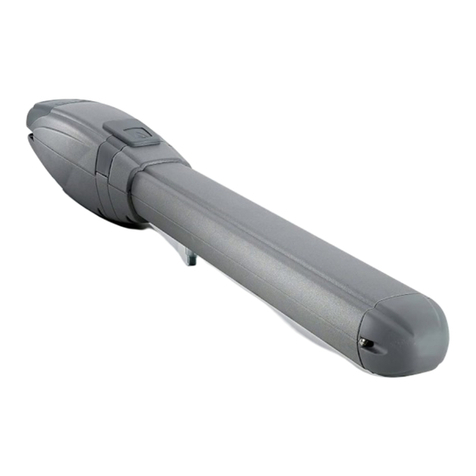
tau
tau ARM2000 User manual

tau
tau D770M Technical specifications

tau
tau 700BOXR18CT User manual
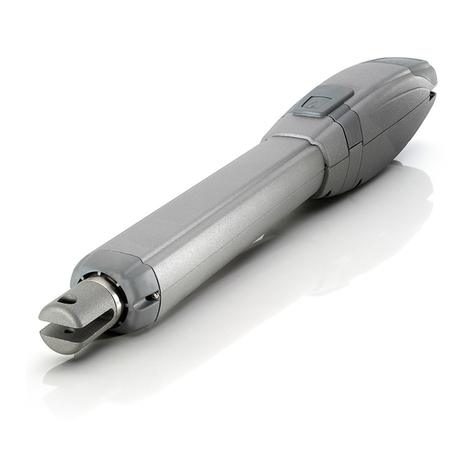
tau
tau ARM200 Series User manual
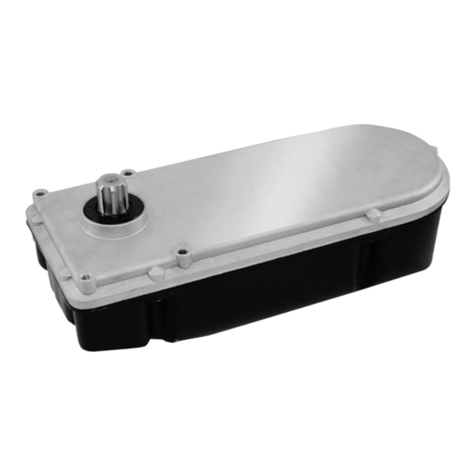
tau
tau R18 series User manual

tau
tau 900TWC User manual
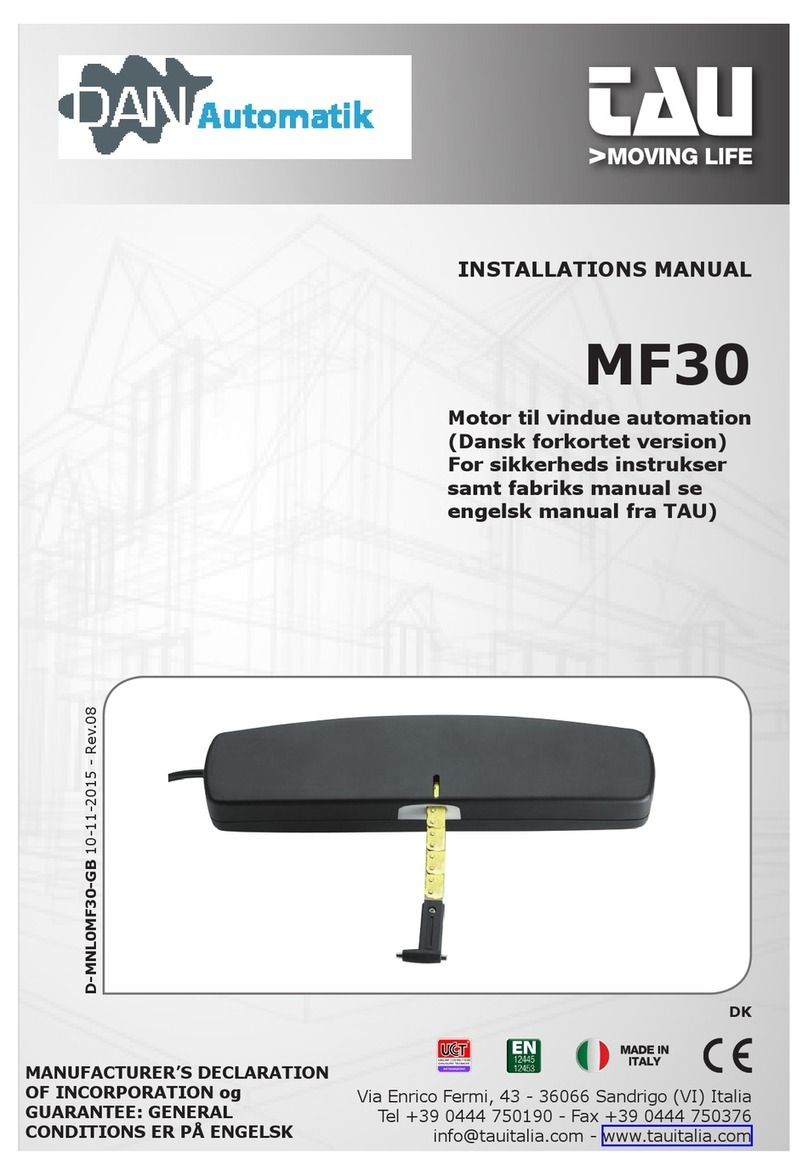
tau
tau DAN Automatik MF30 User manual
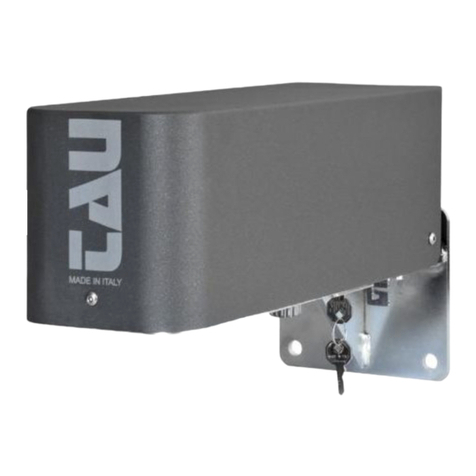
tau
tau ZIPPO Series User manual
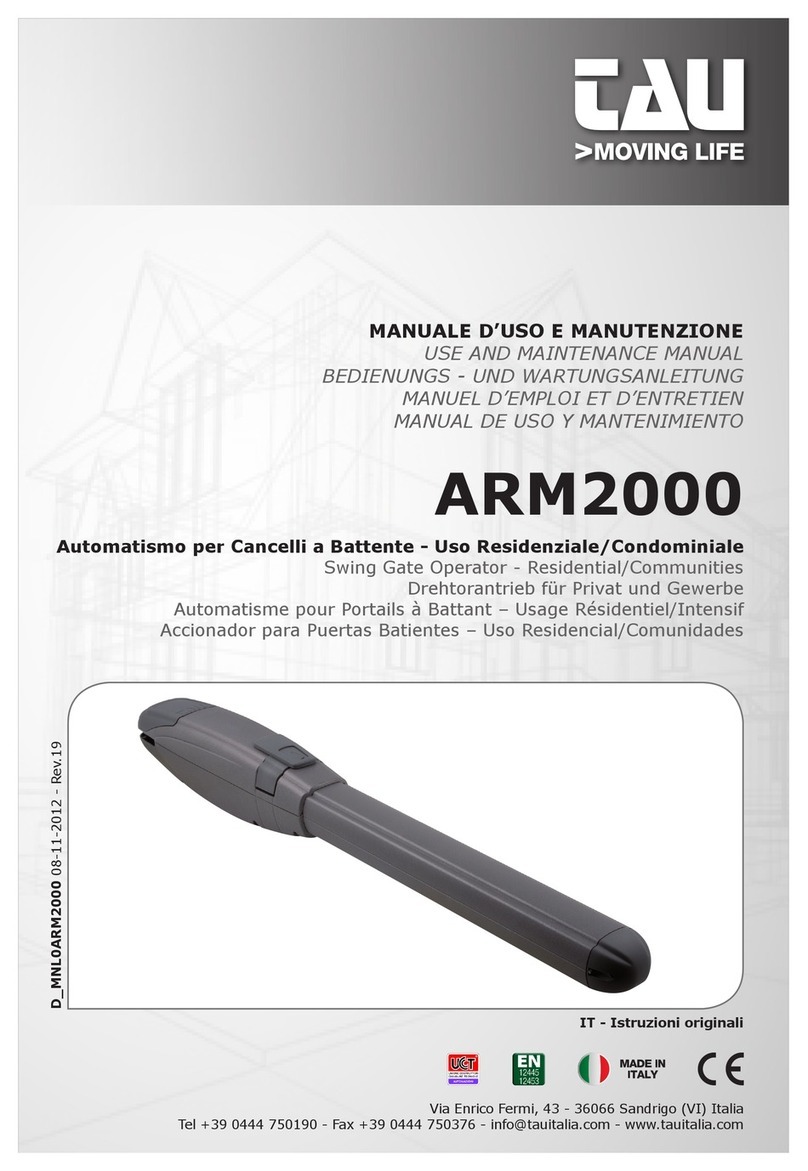
tau
tau ARM2000ENC User manual
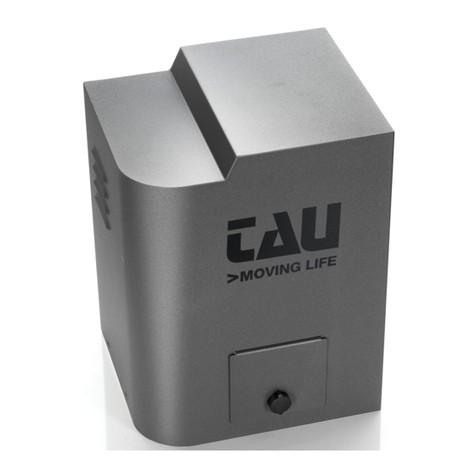
tau
tau BIG Series User manual
Popular Gate Opener manuals by other brands
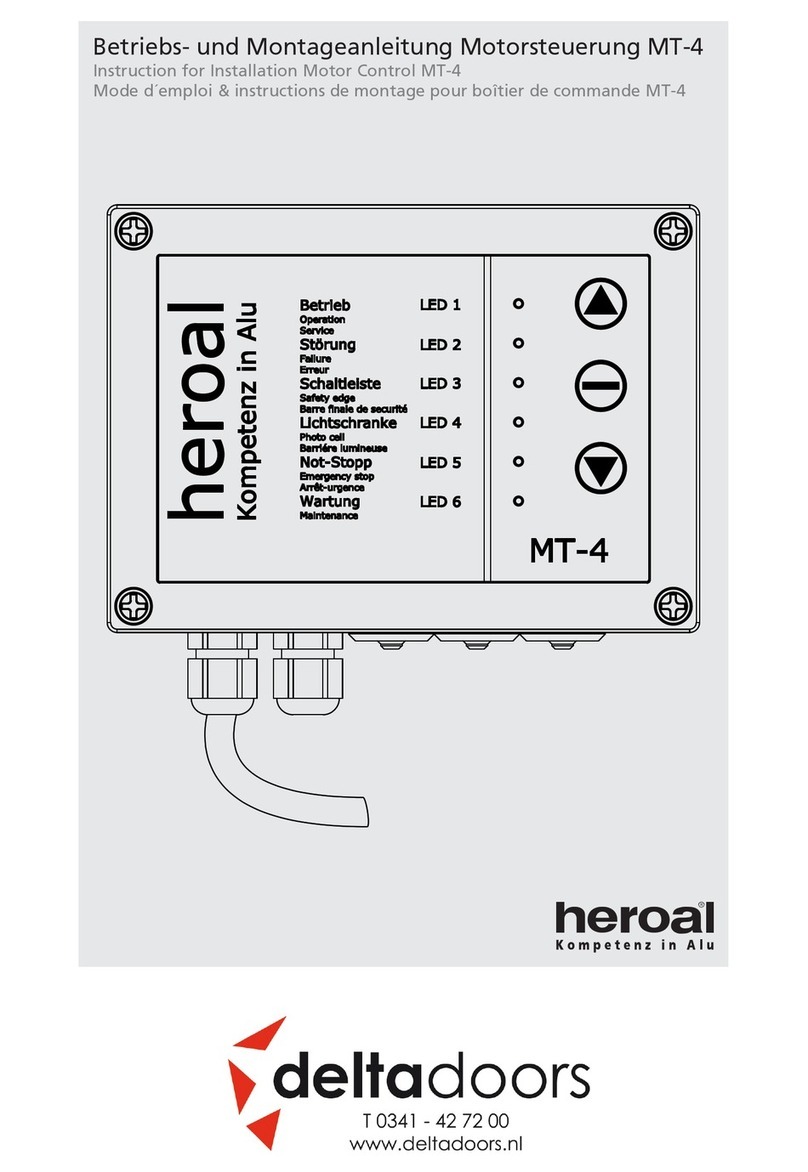
Deltadoors
Deltadoors heroal MT-4 Instructions for installation
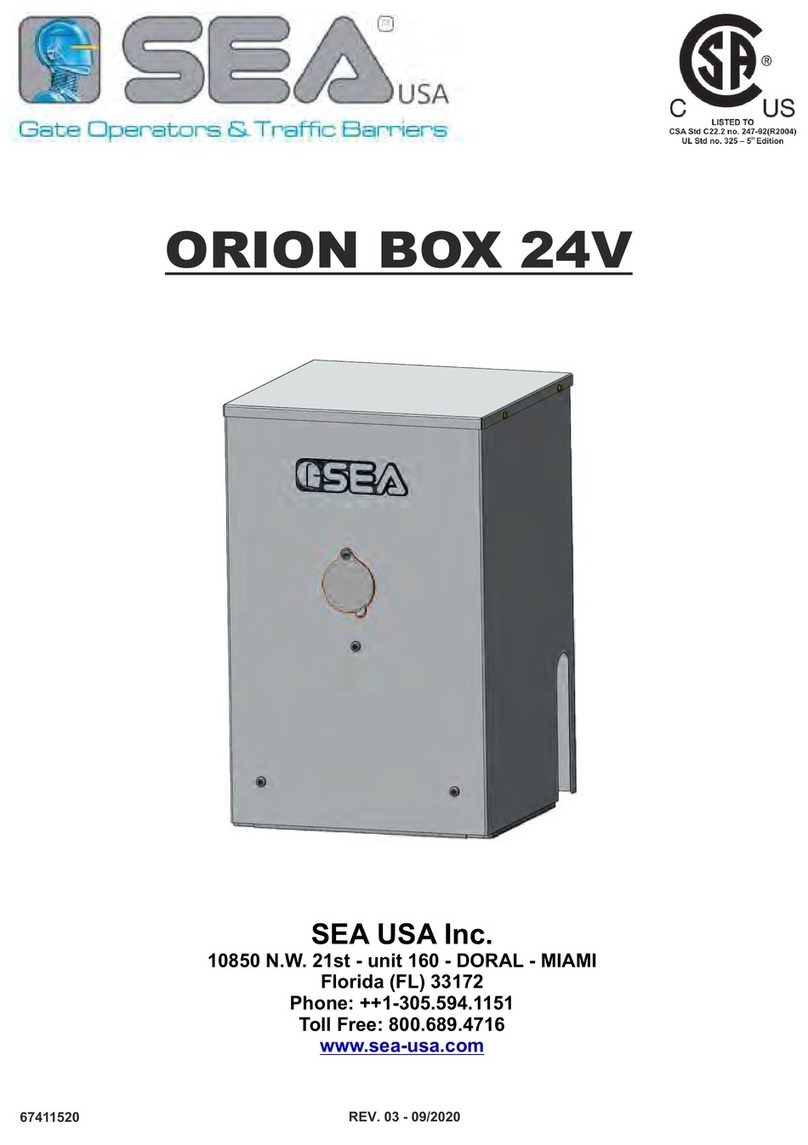
SEA
SEA ORION BOX 24V manual
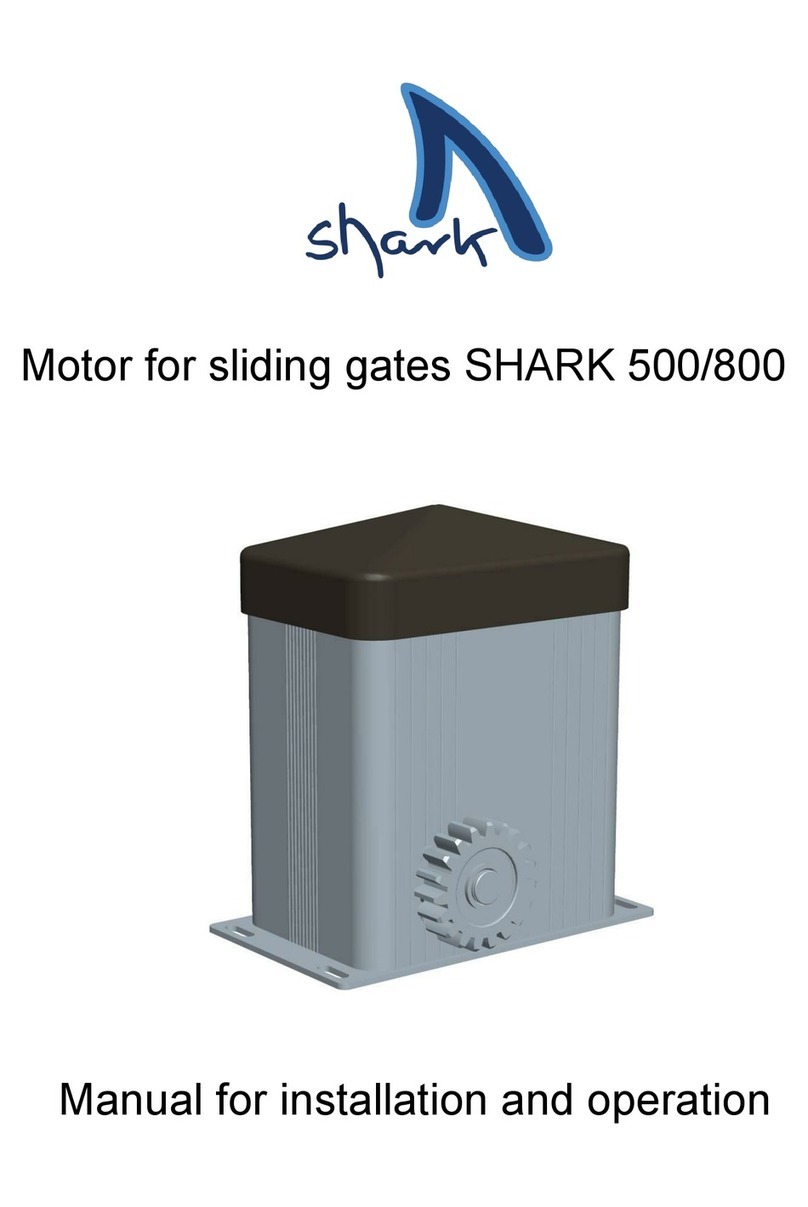
Shark
Shark 500KG Manual for installation and operation
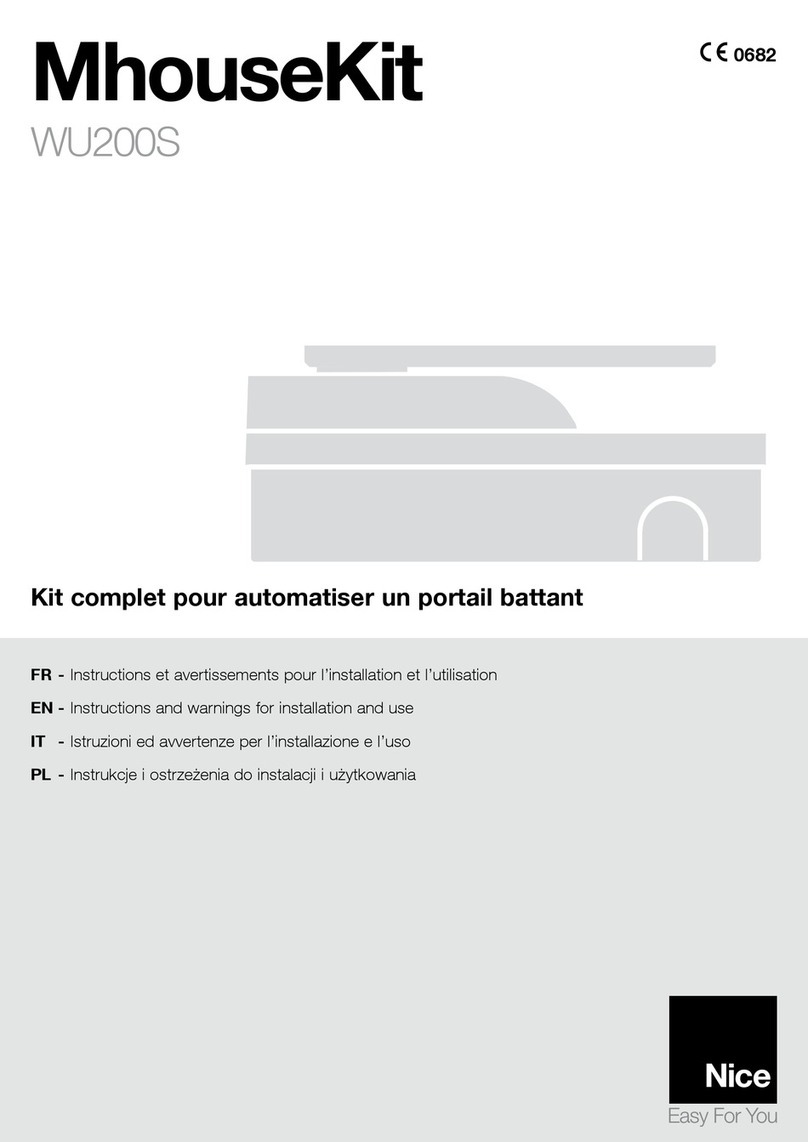
Nice
Nice MhouseKit WU200S Instructions and warnings for installation and use
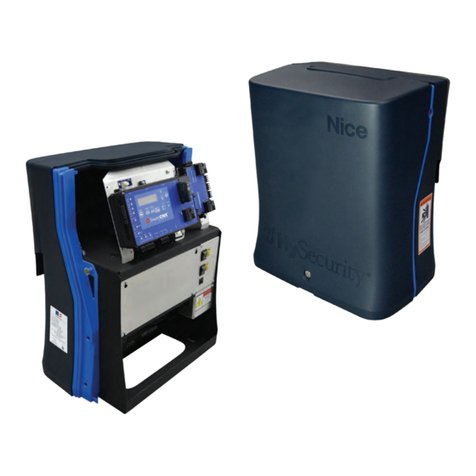
Nice
Nice SlideSmart CNX 15 Installation and programming manual
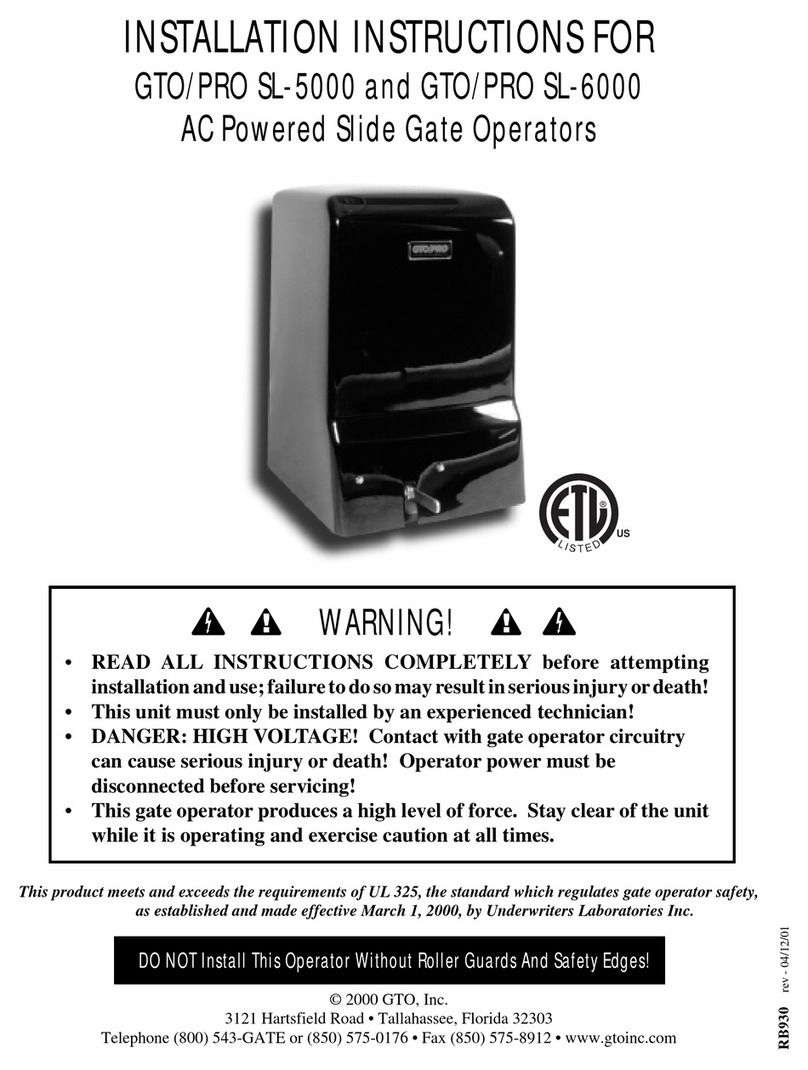
GTO
GTO SL-5000 installation instructions
